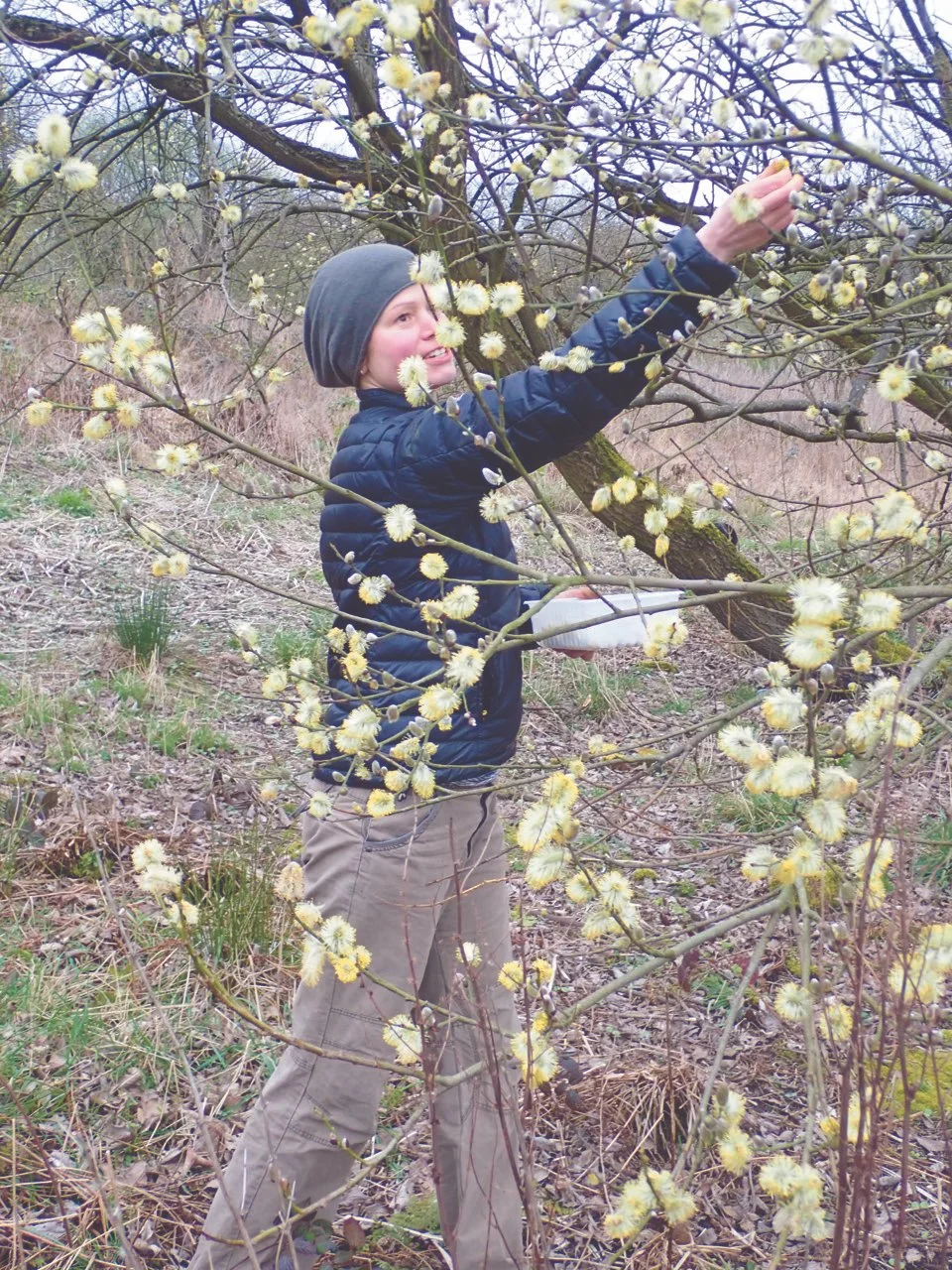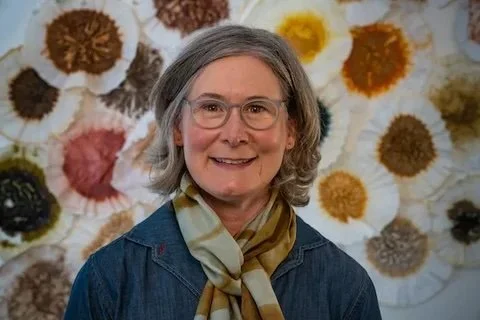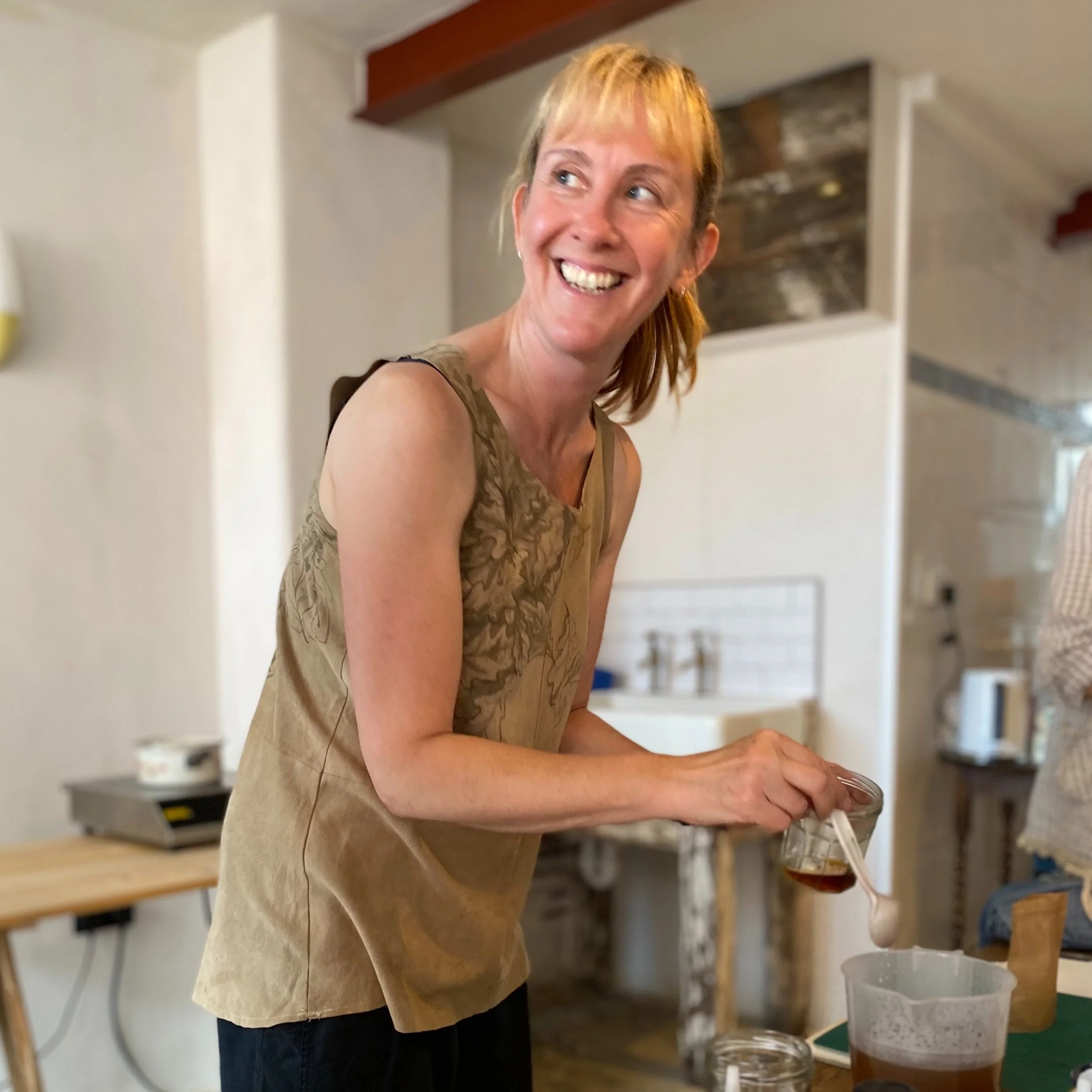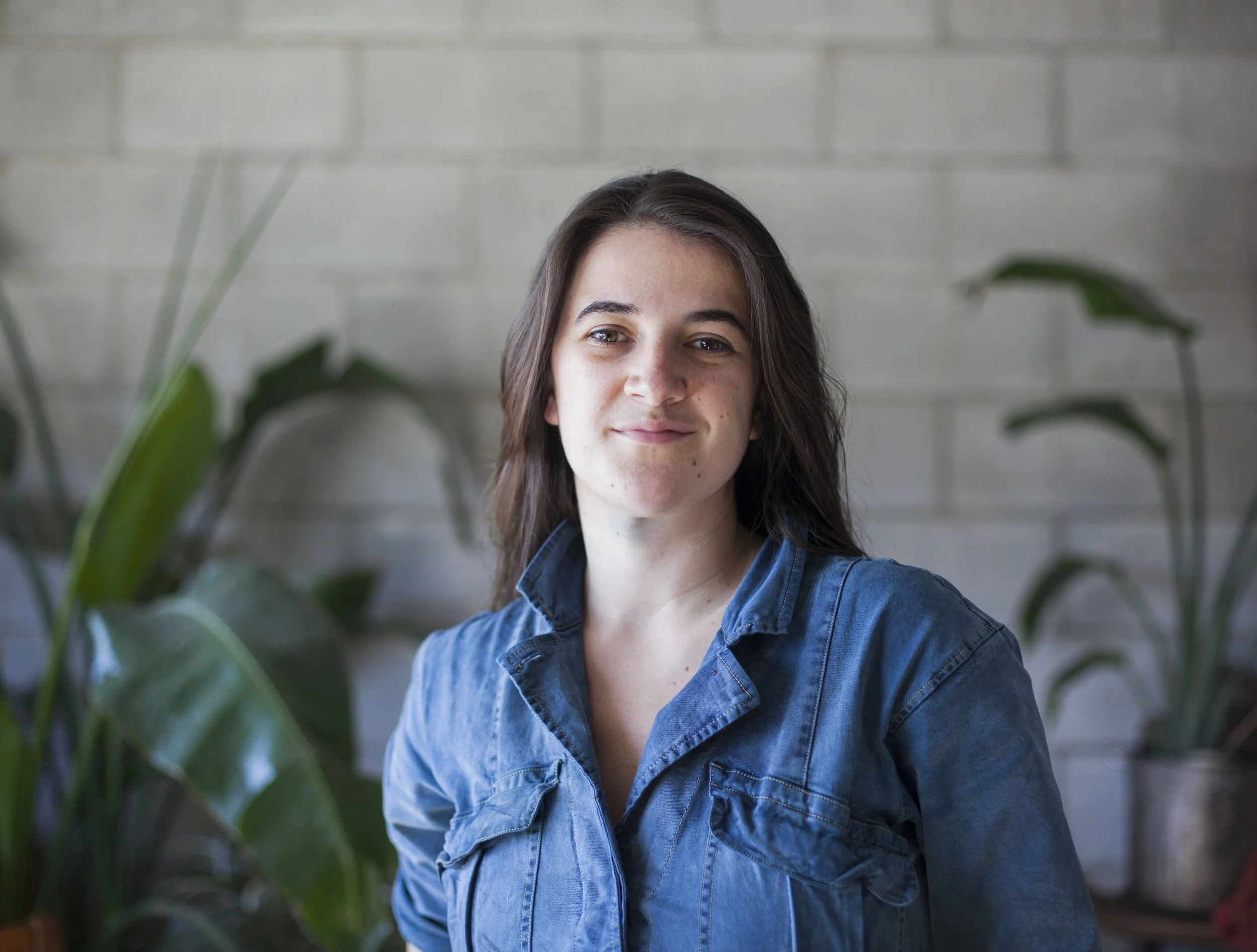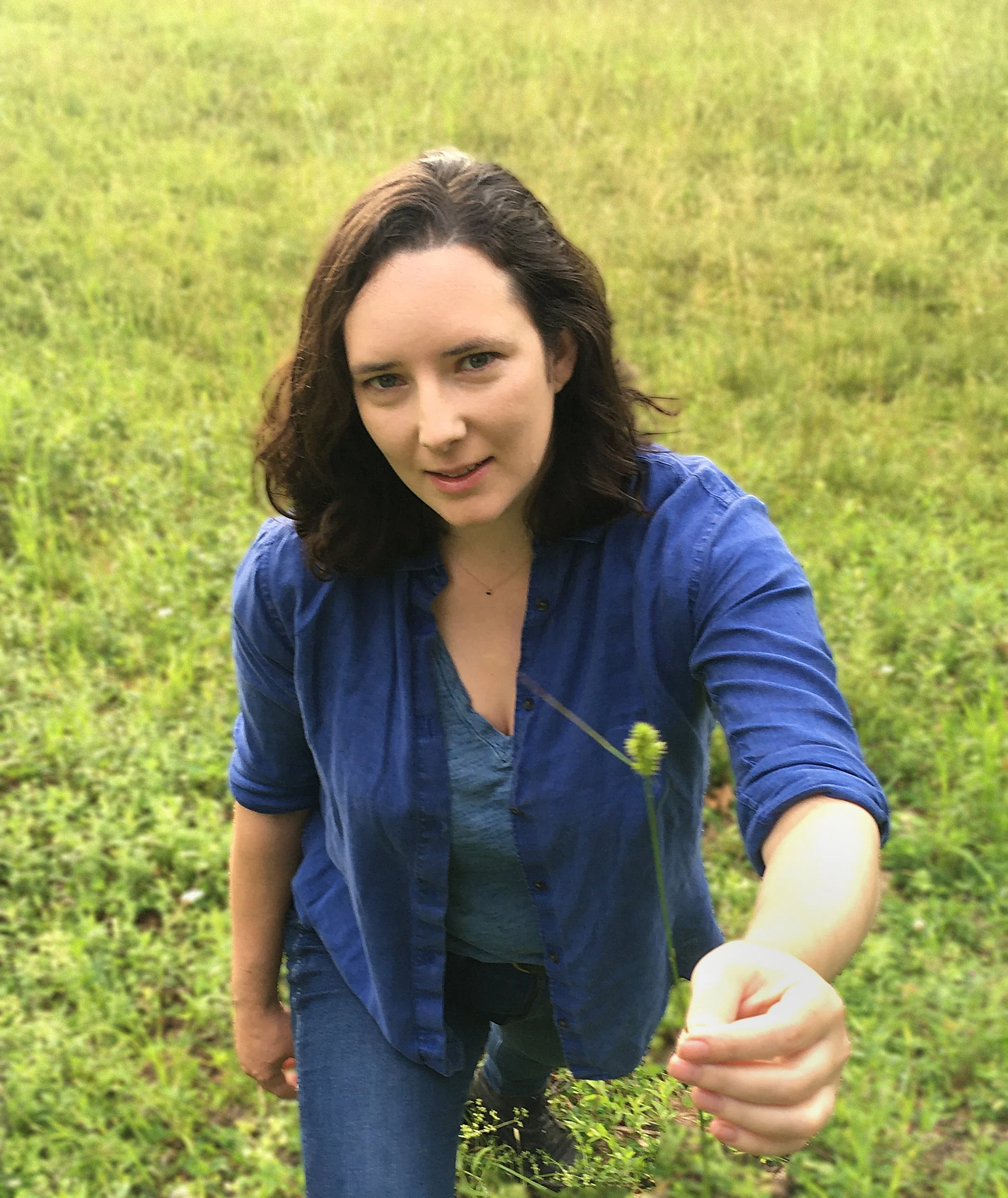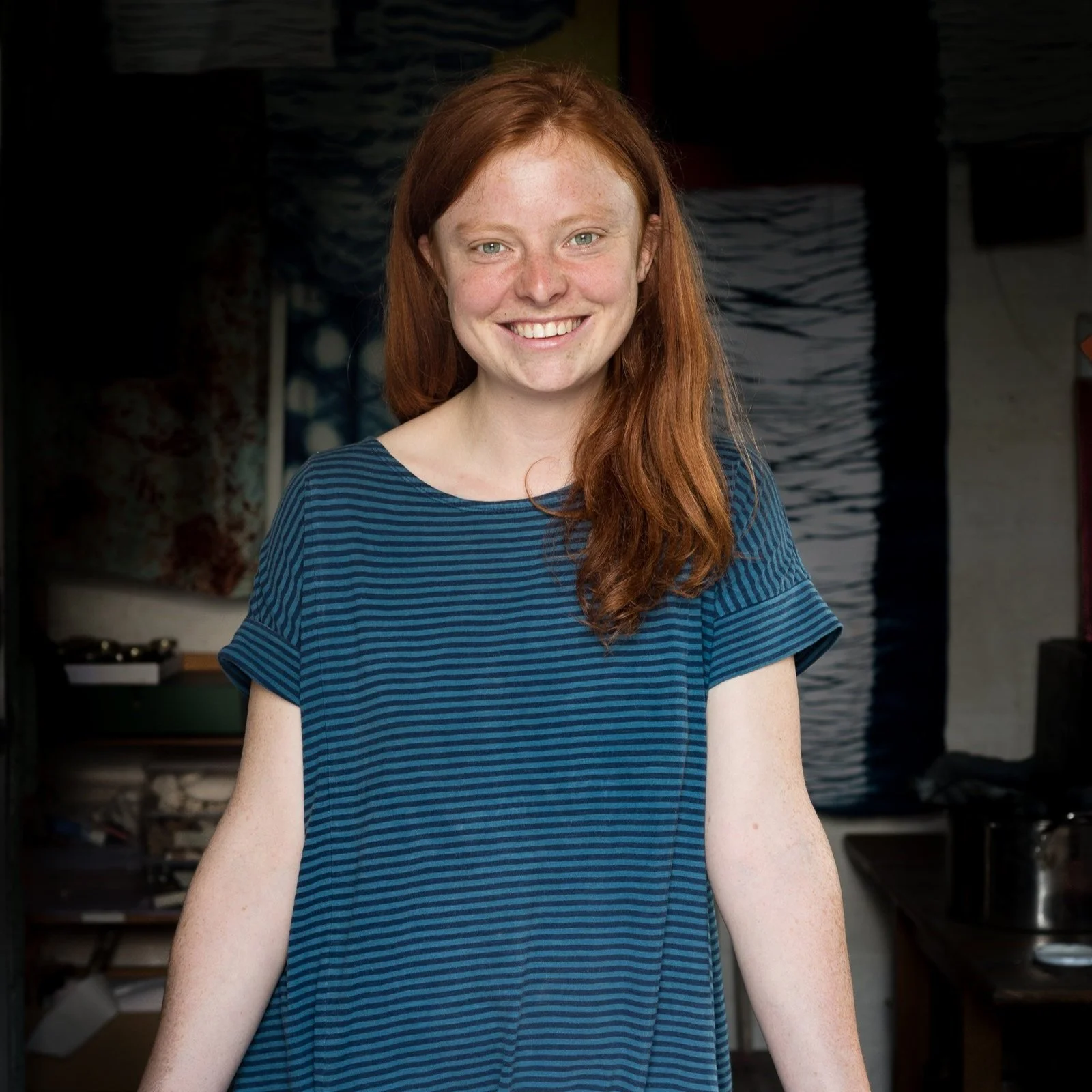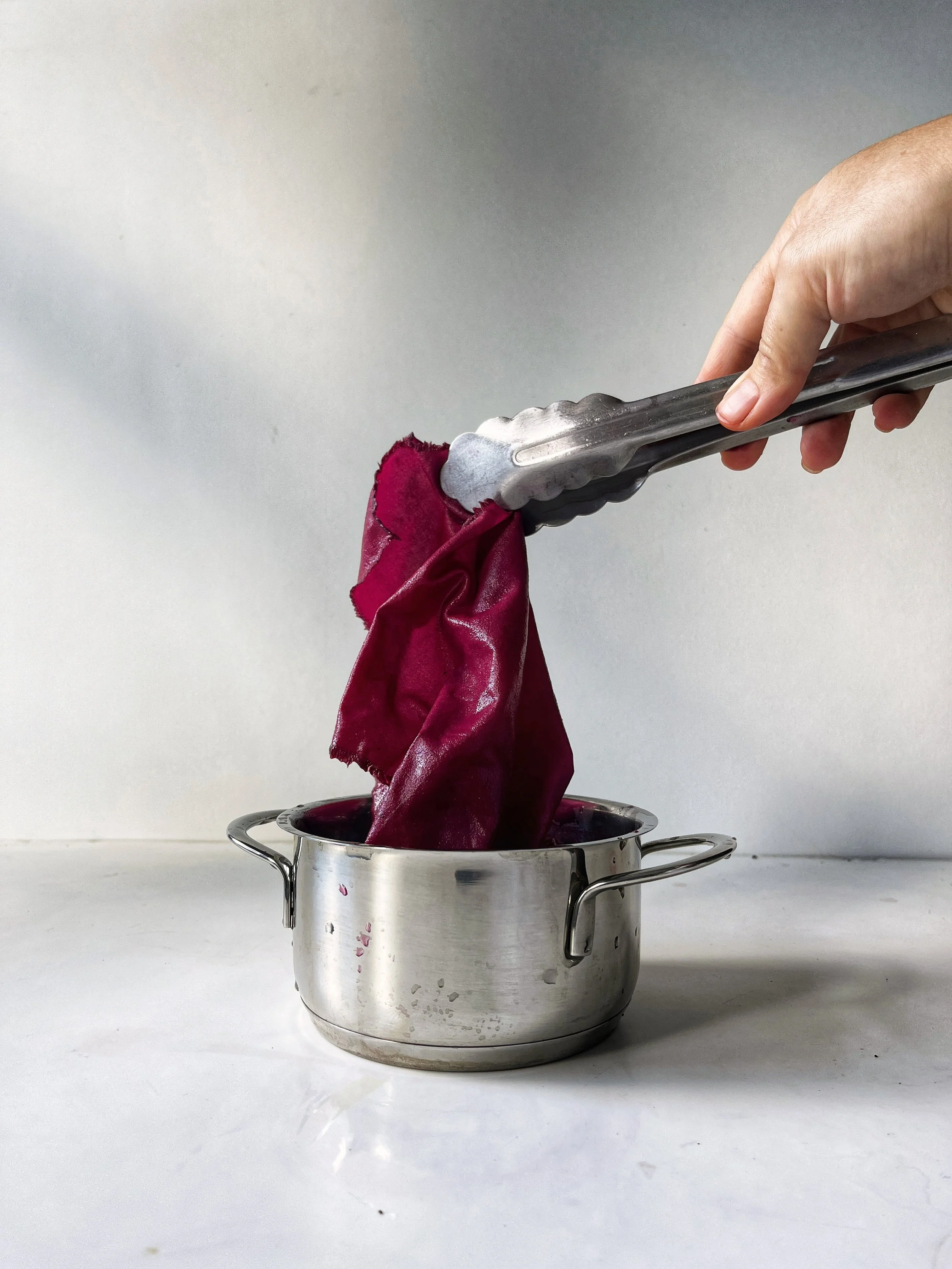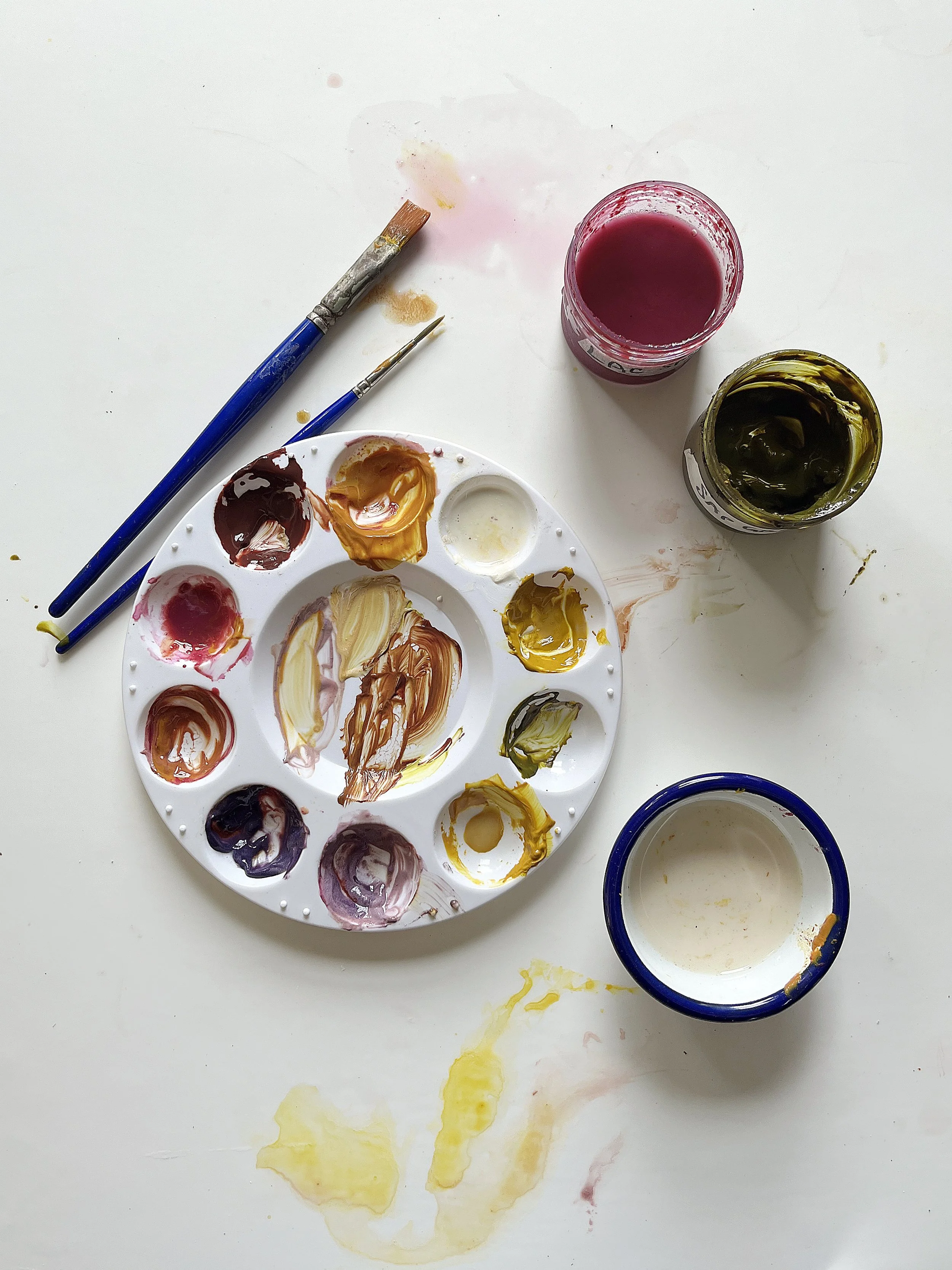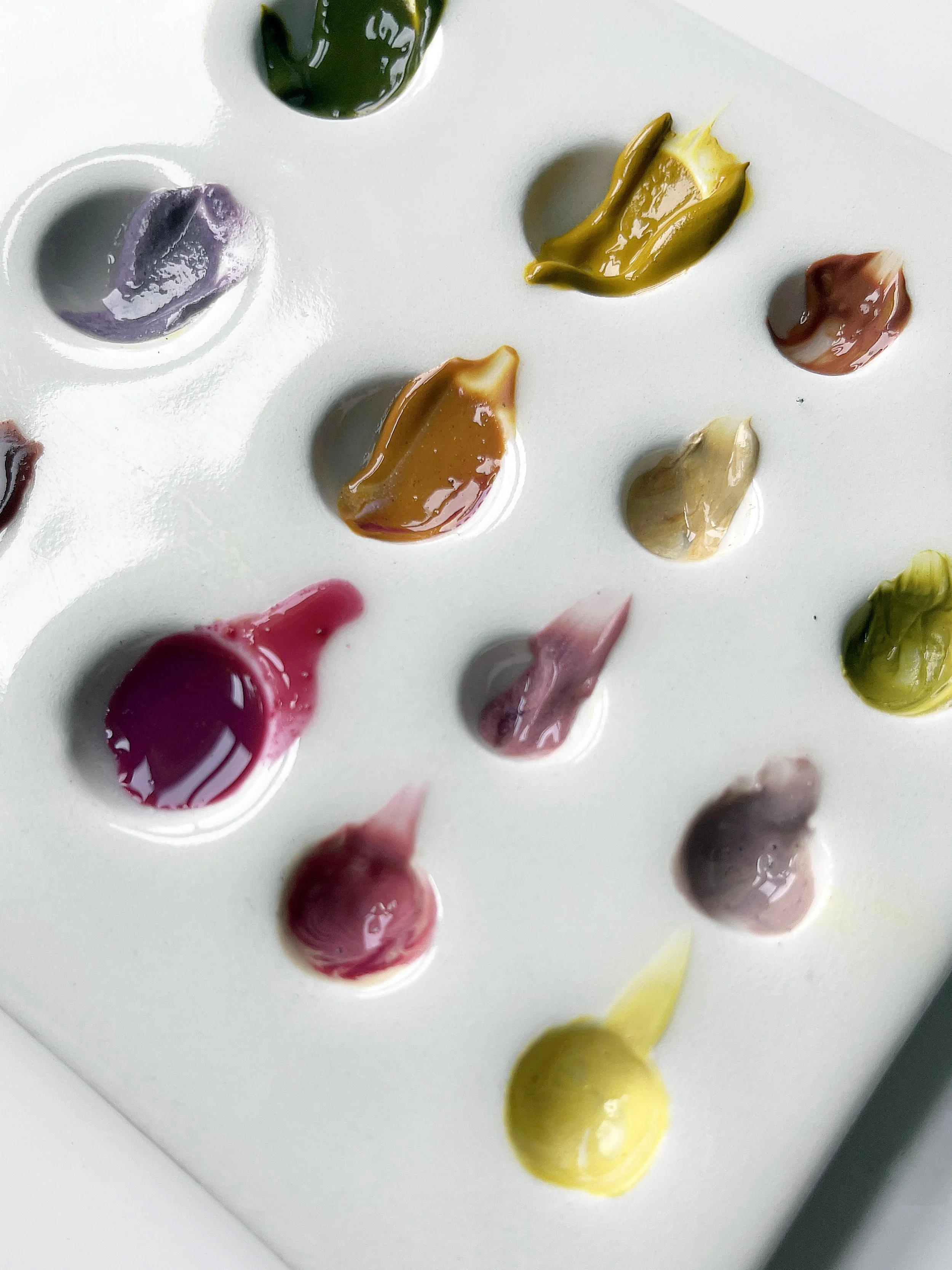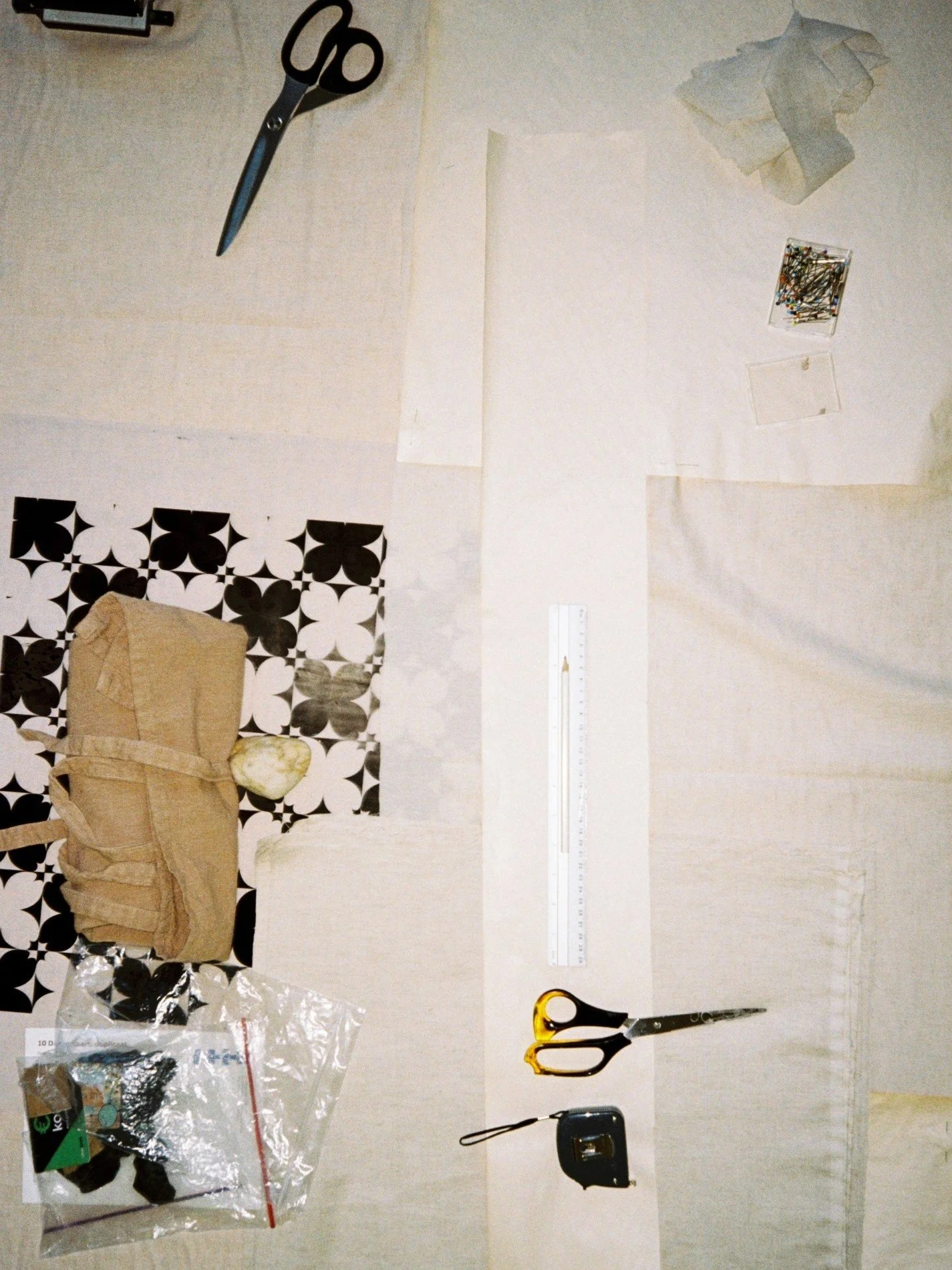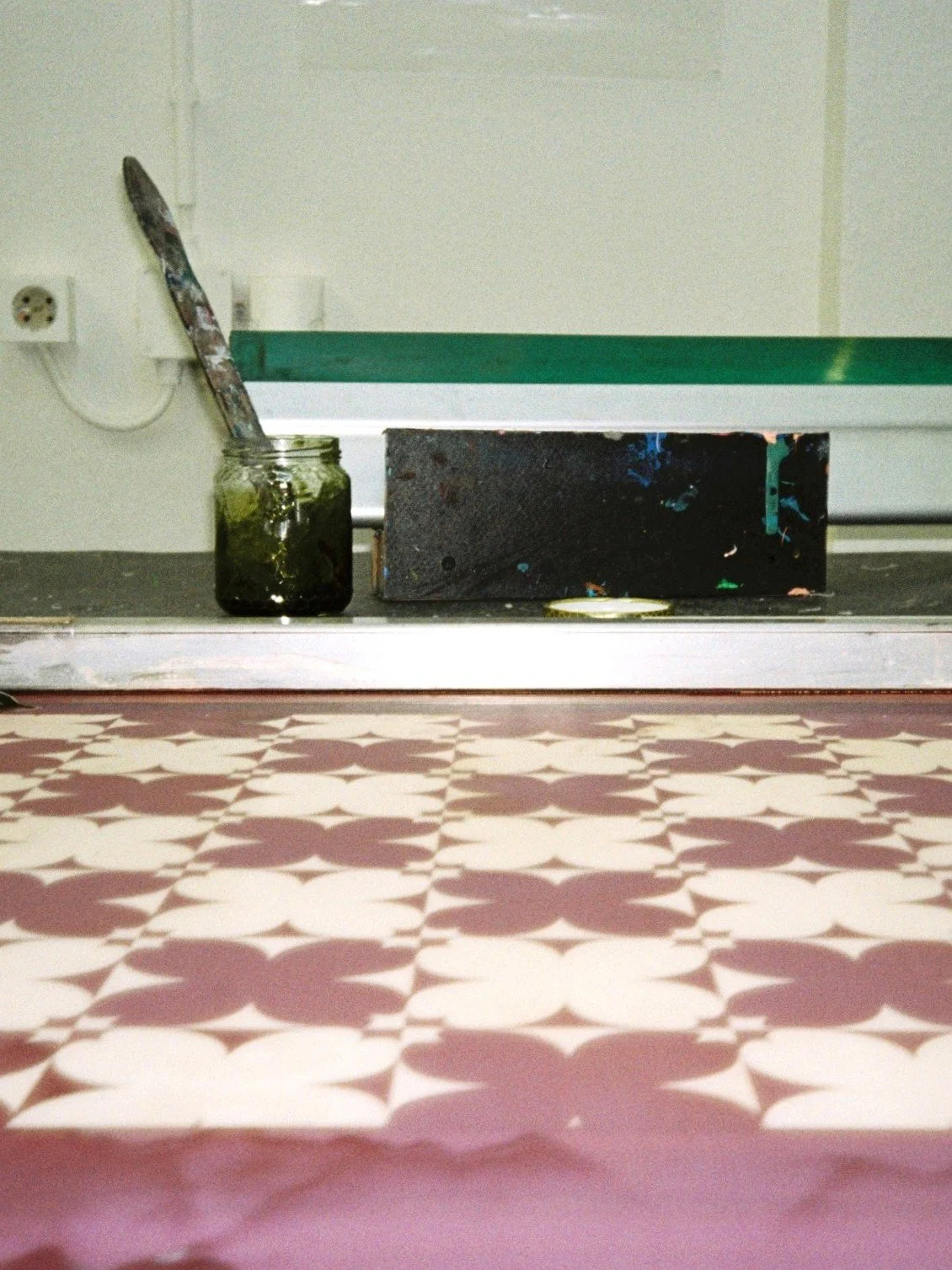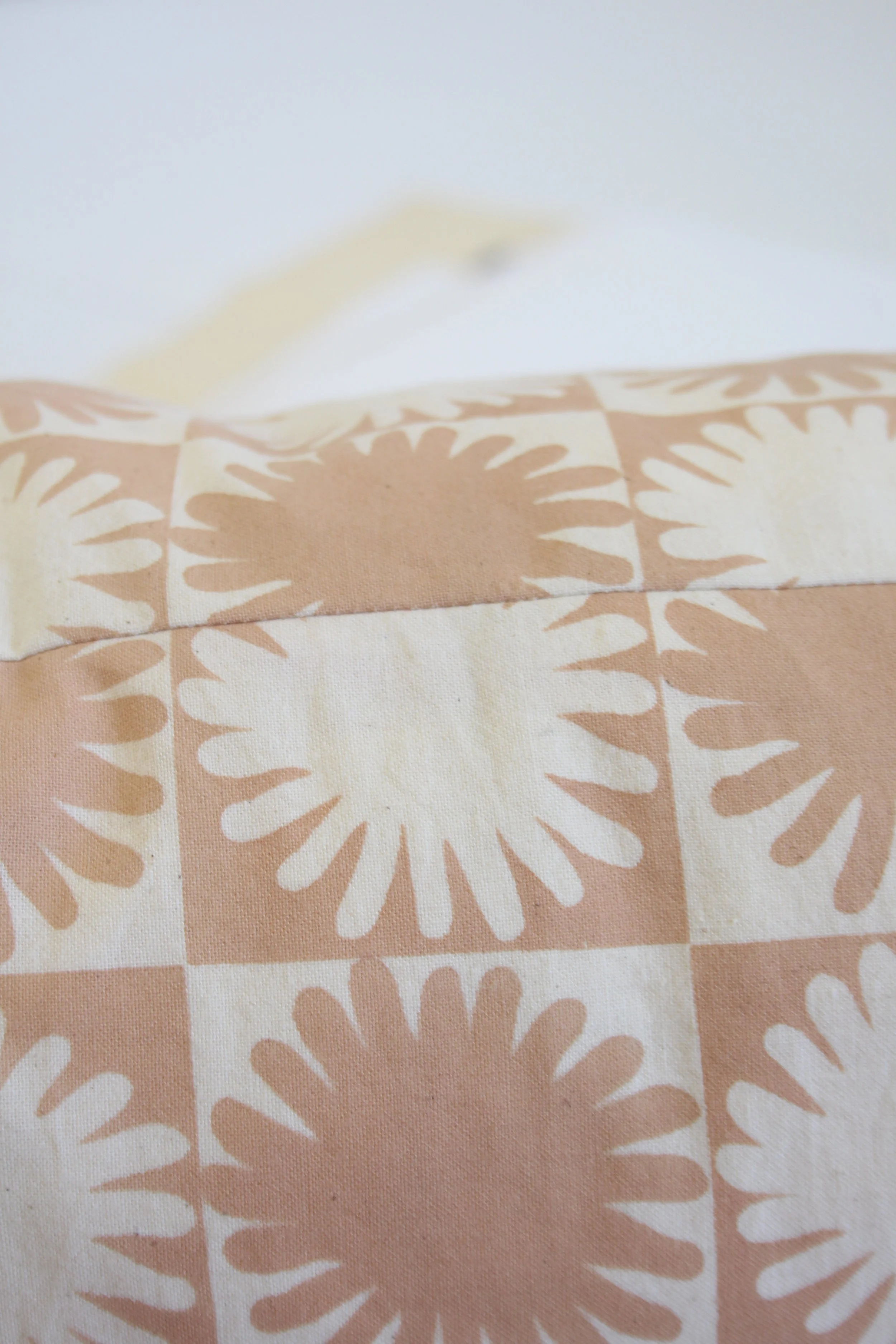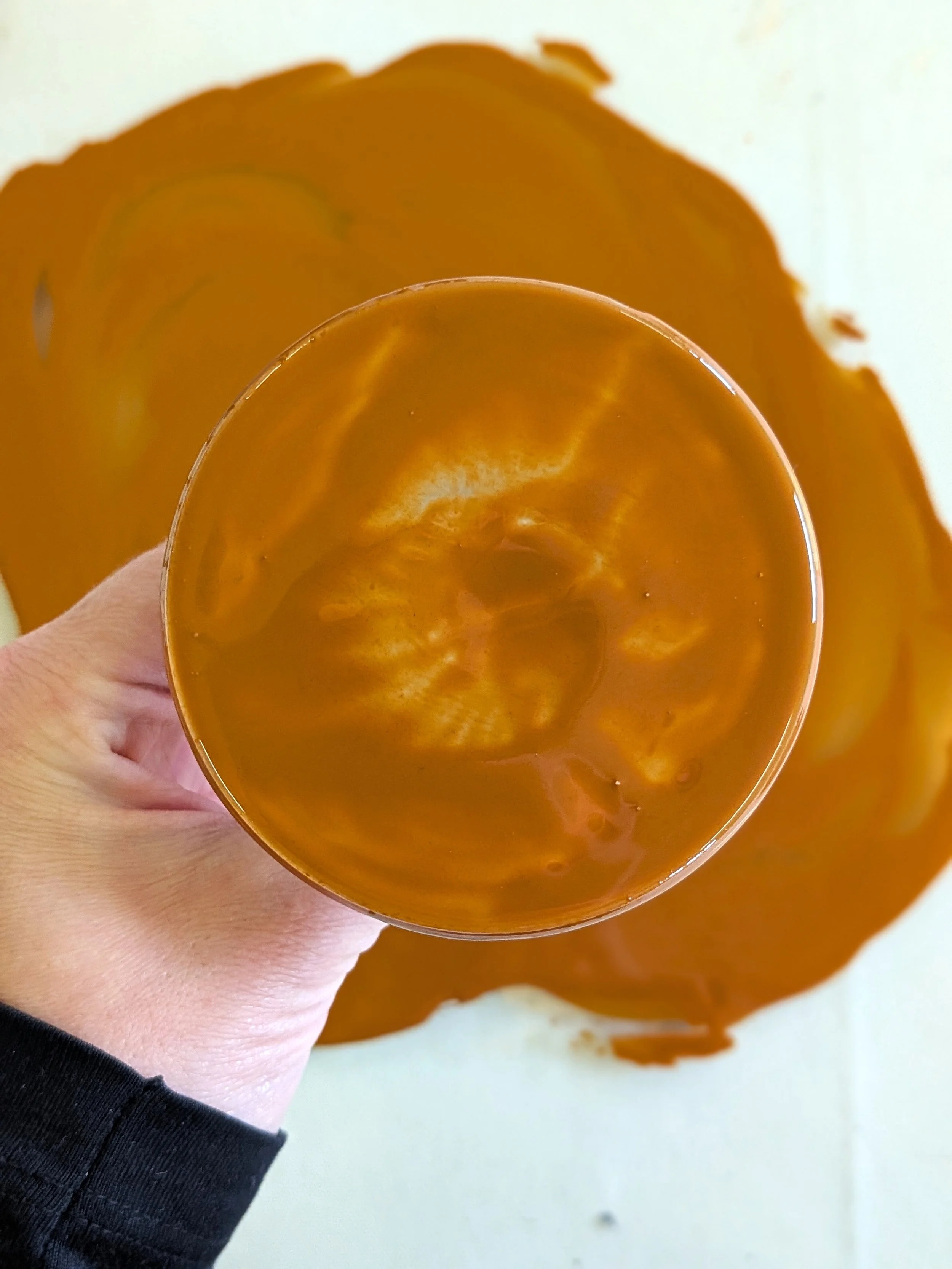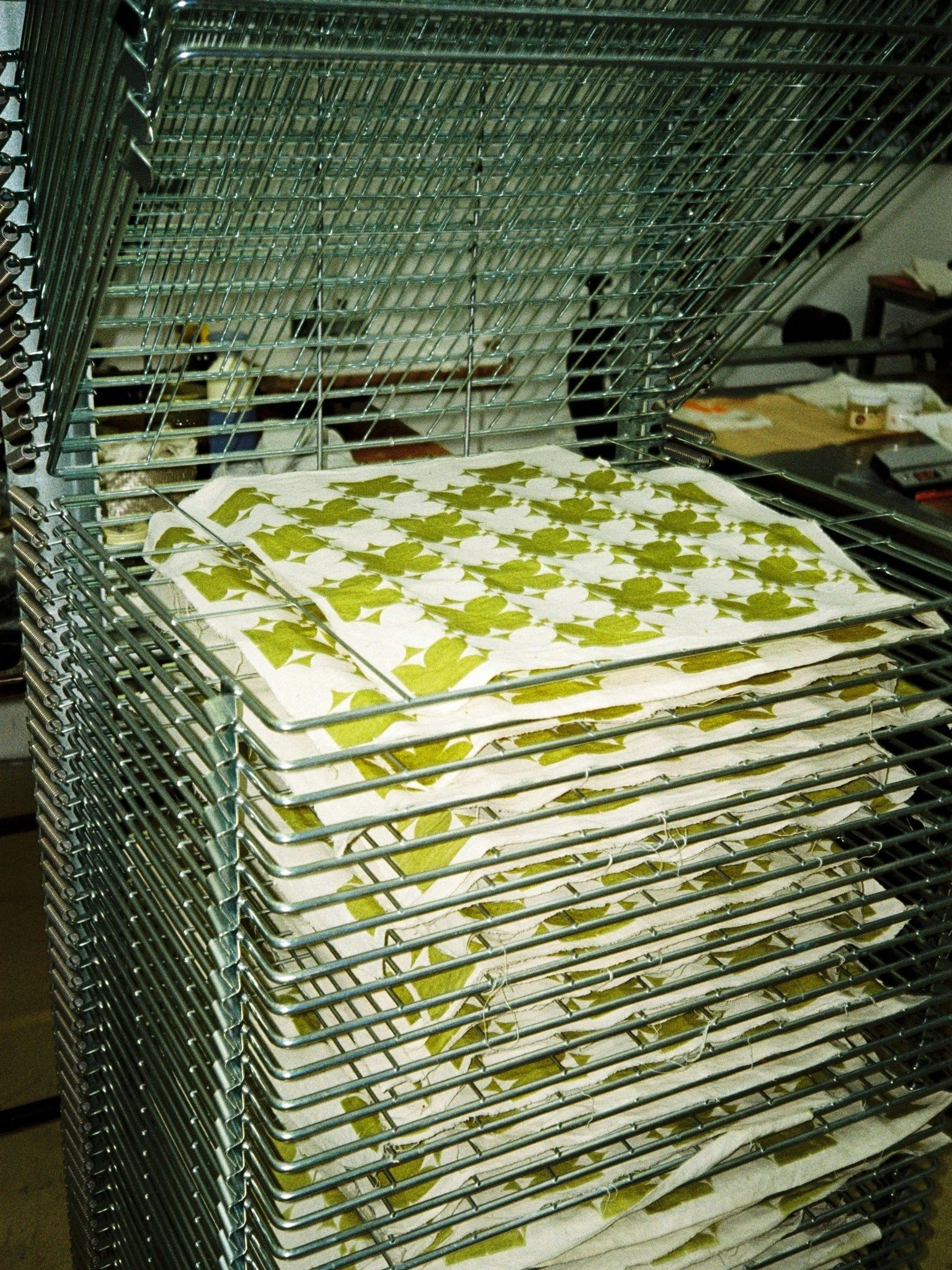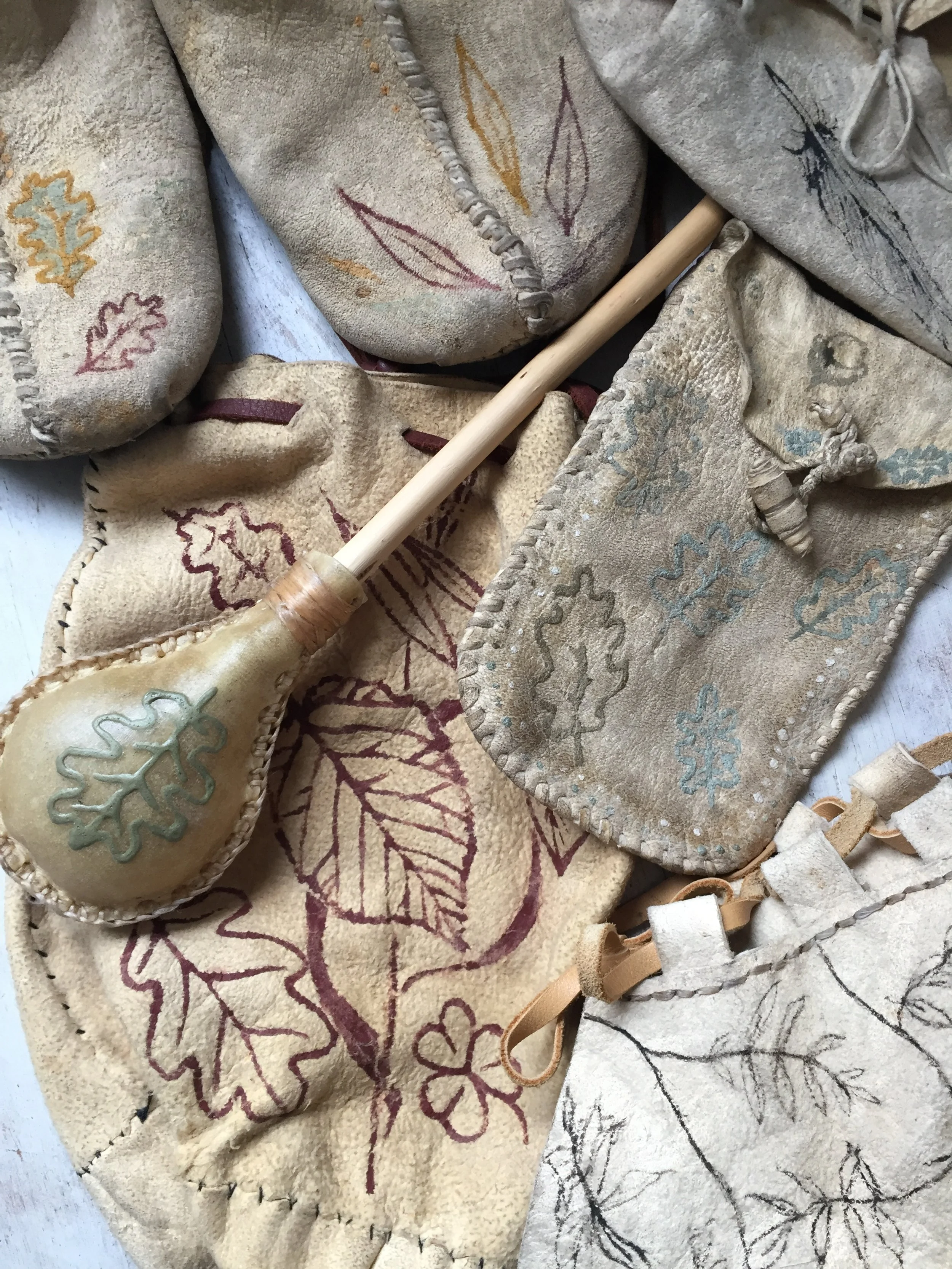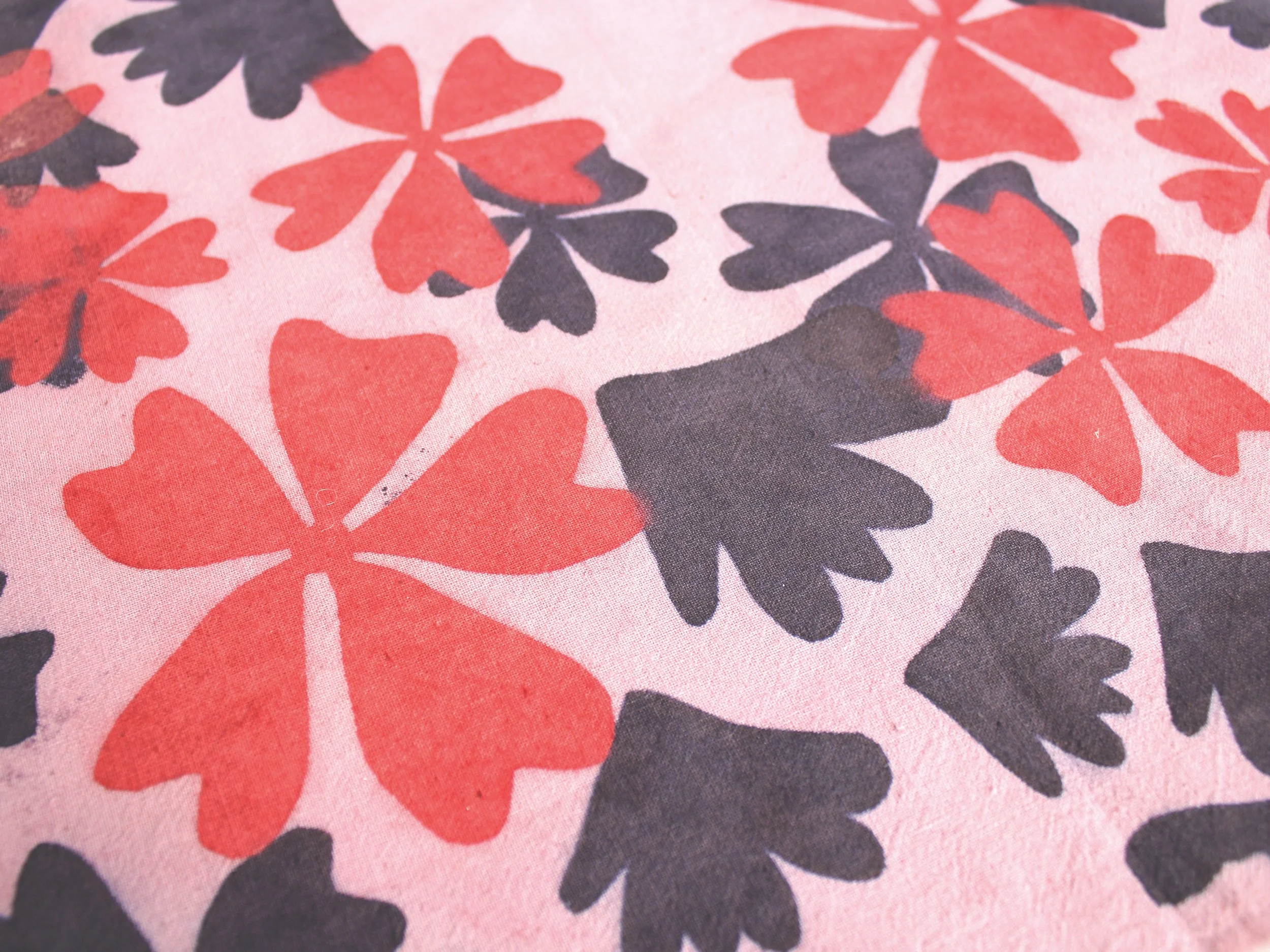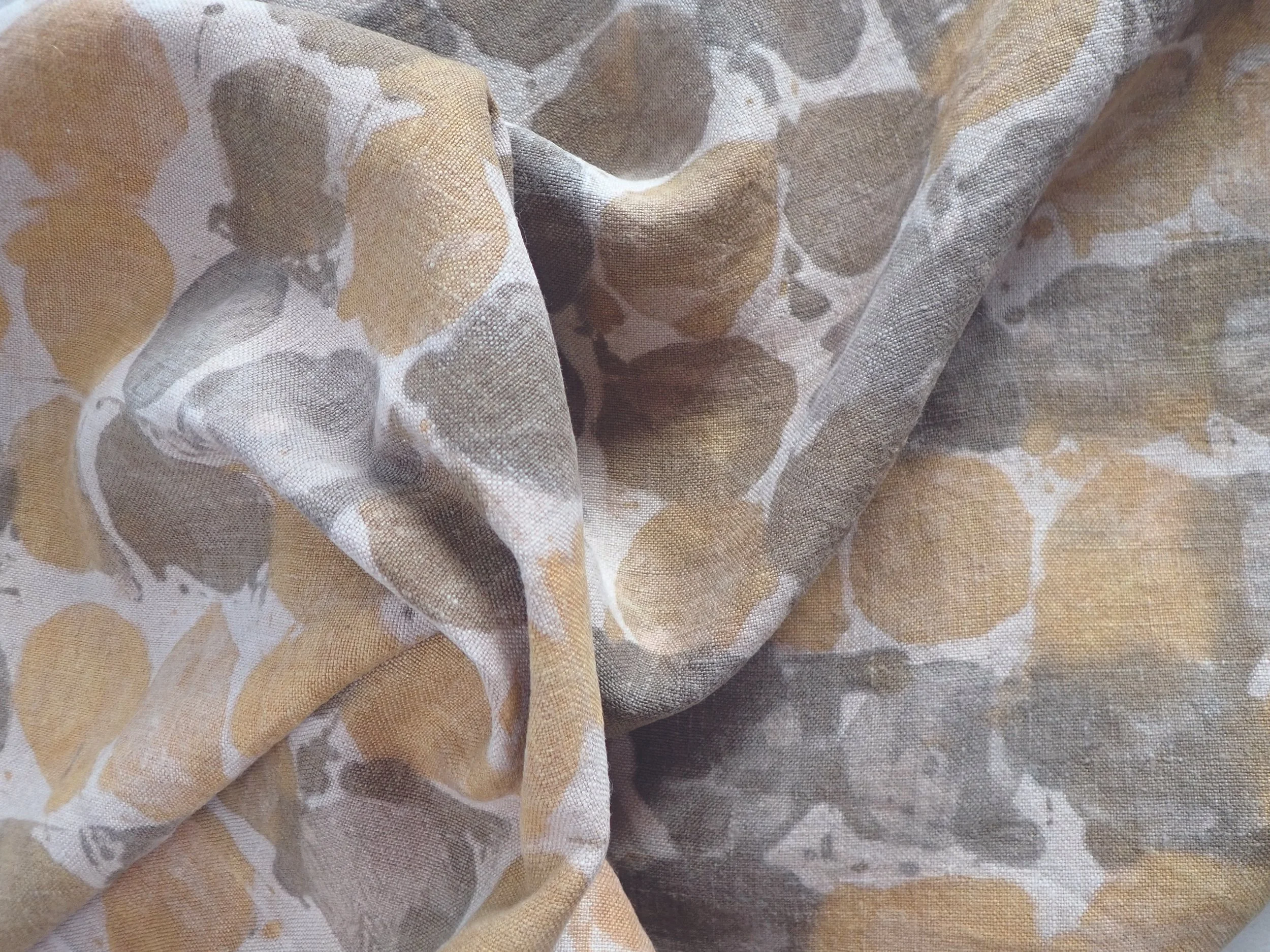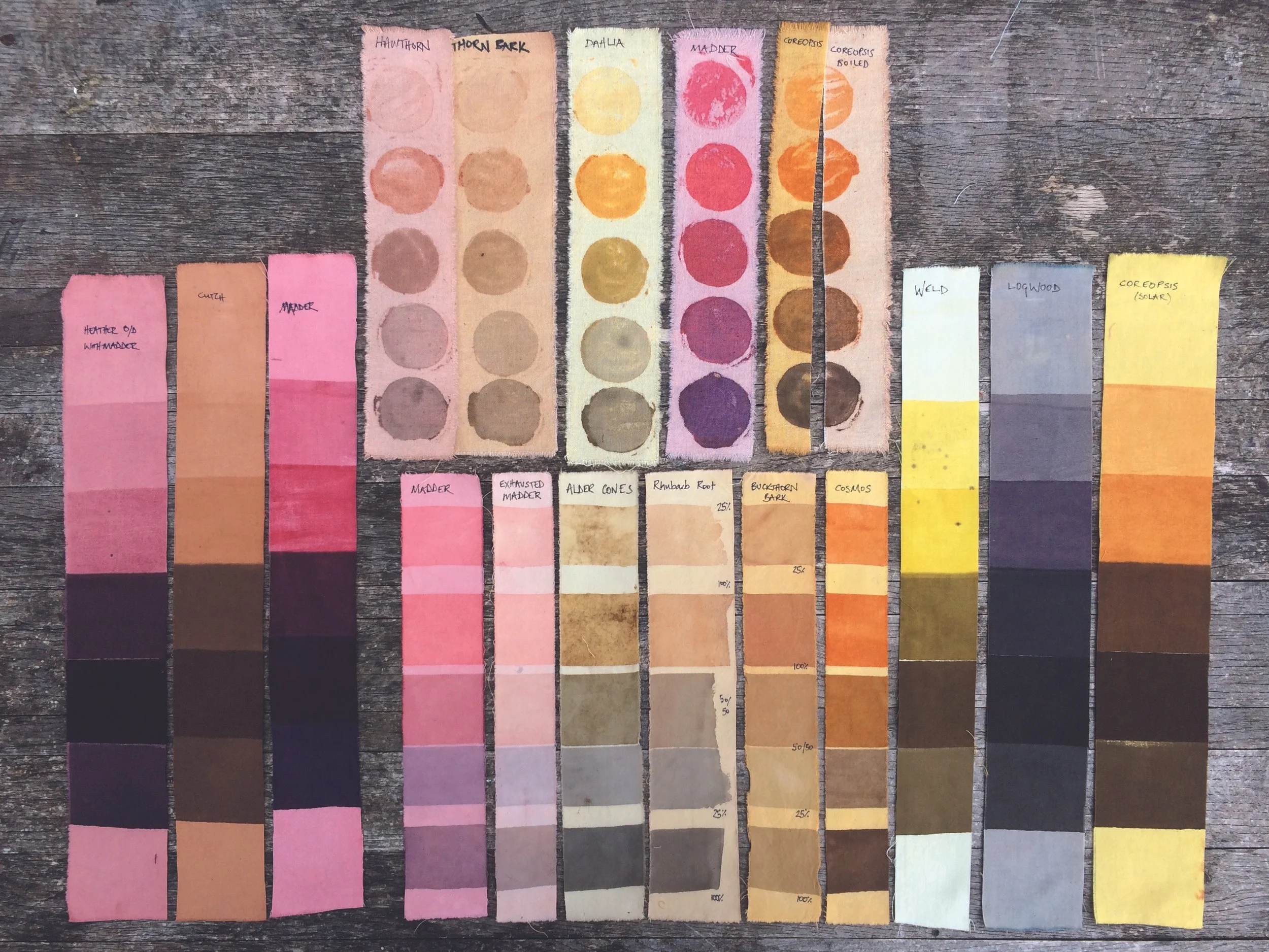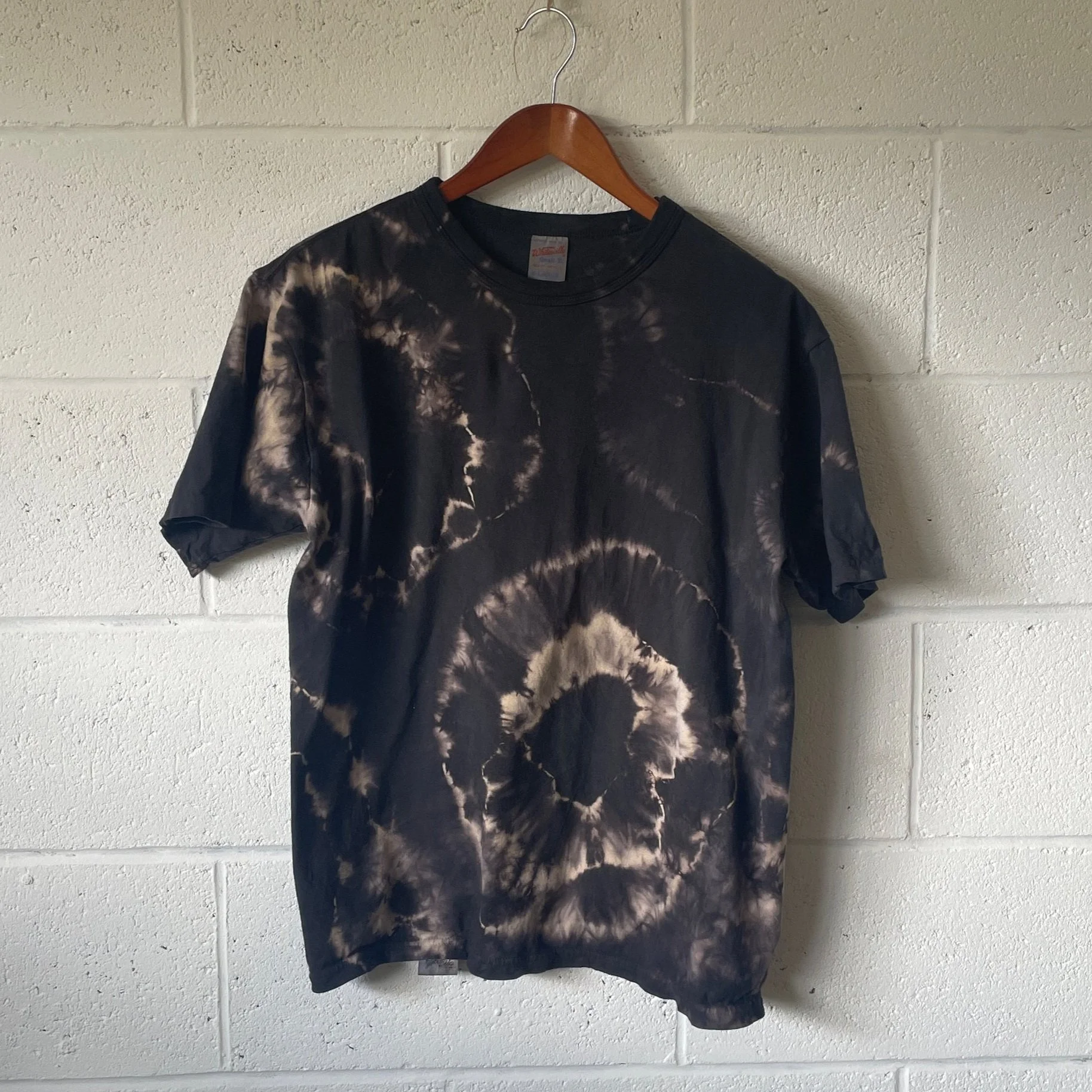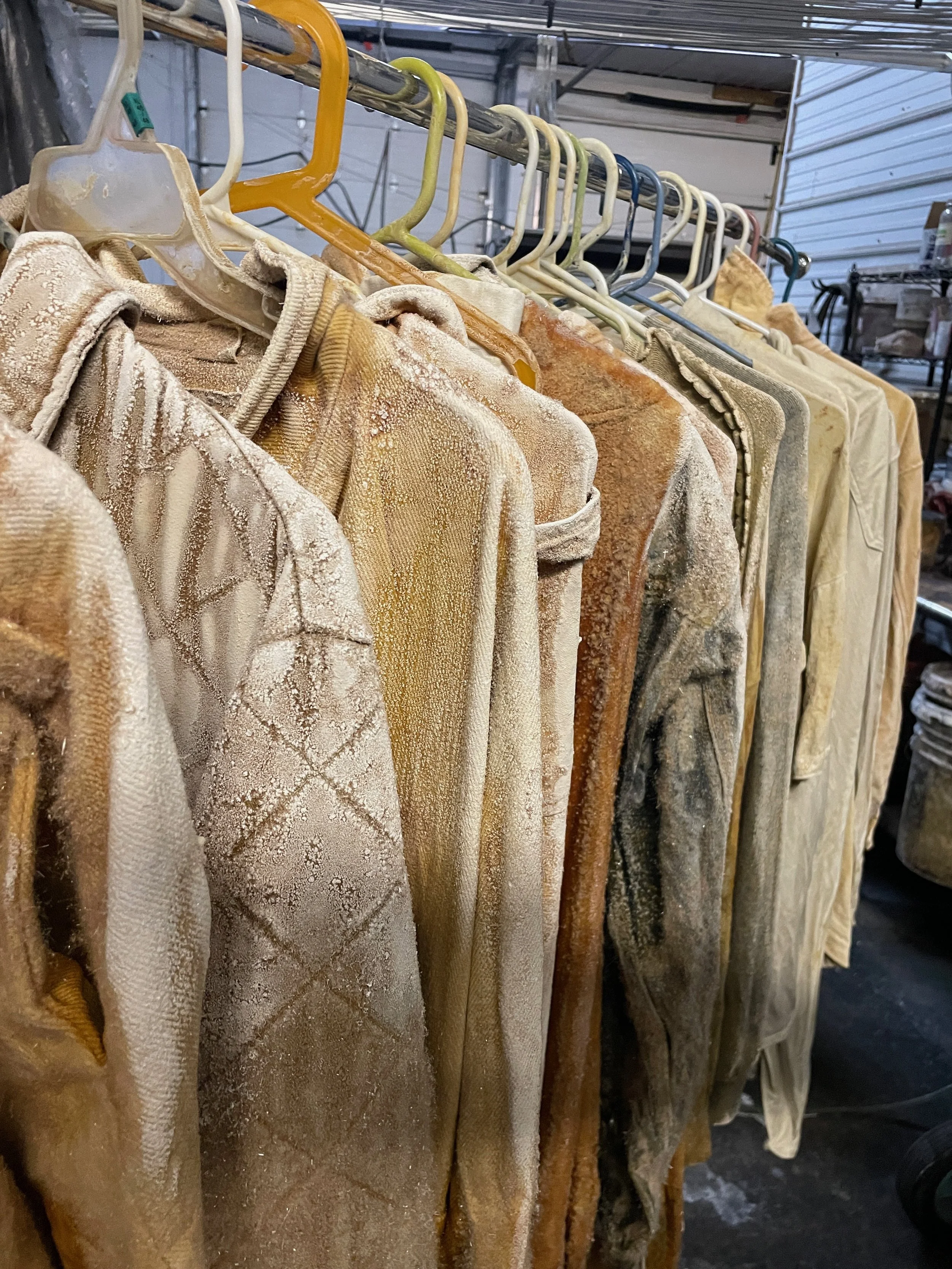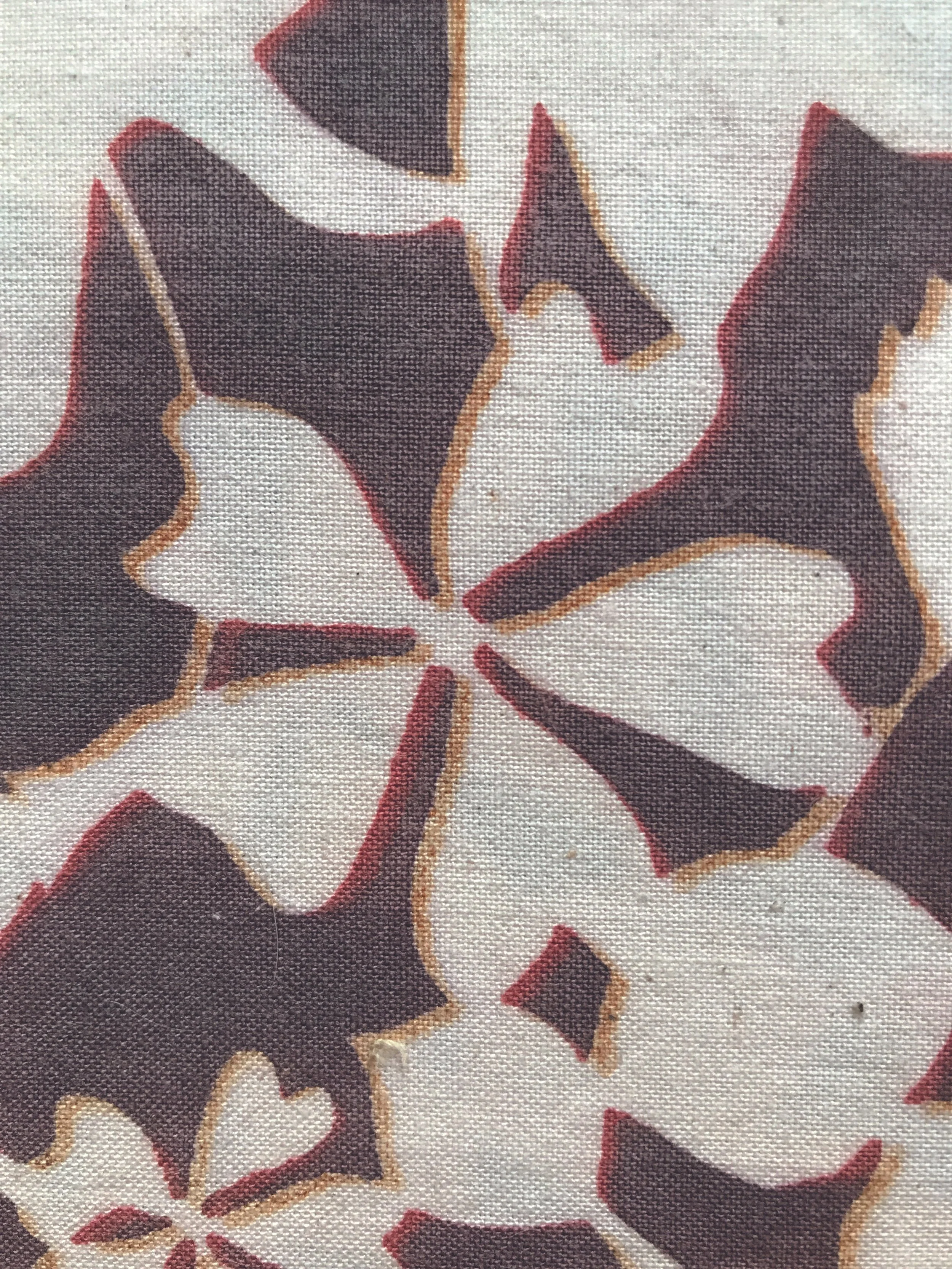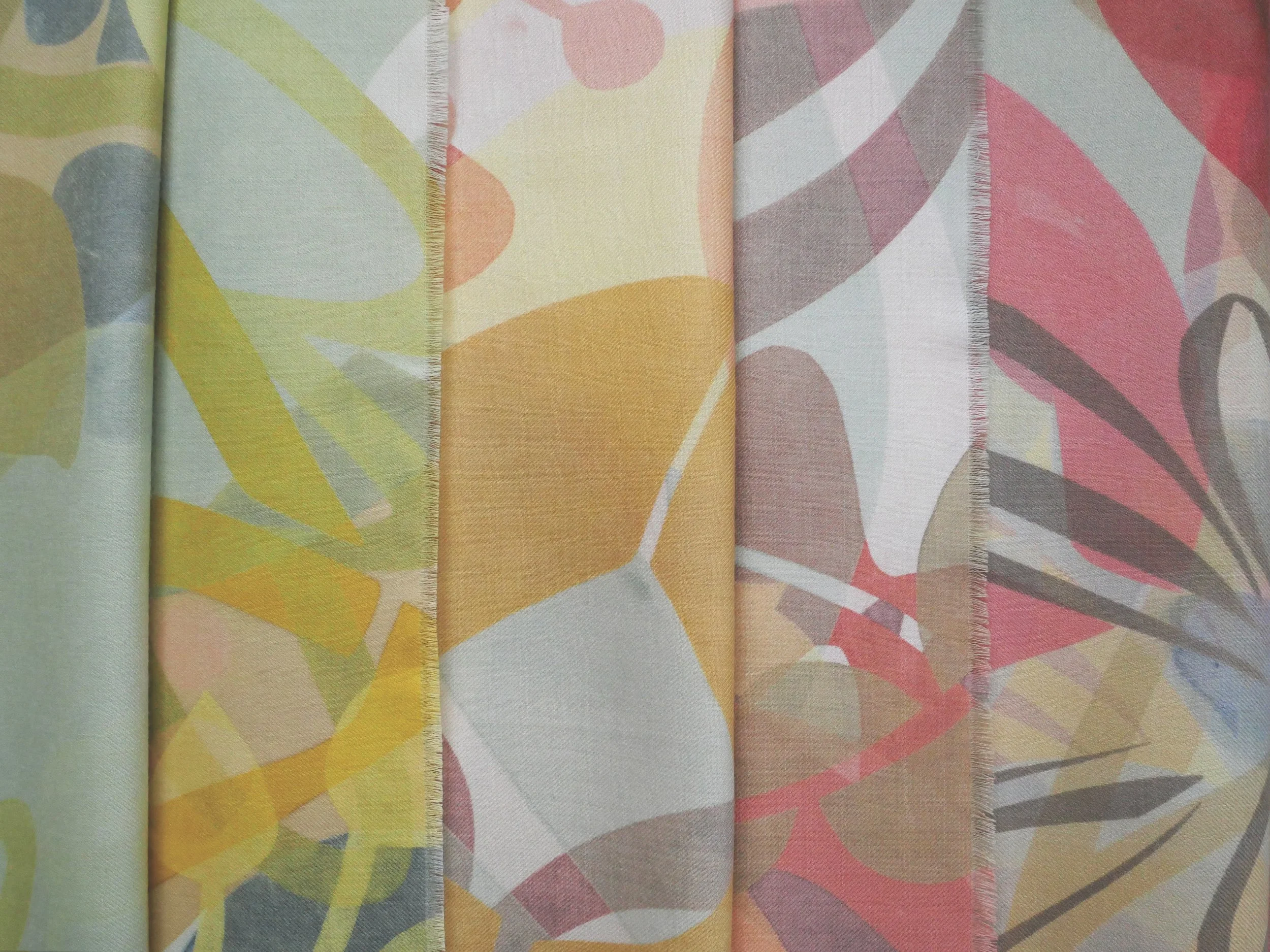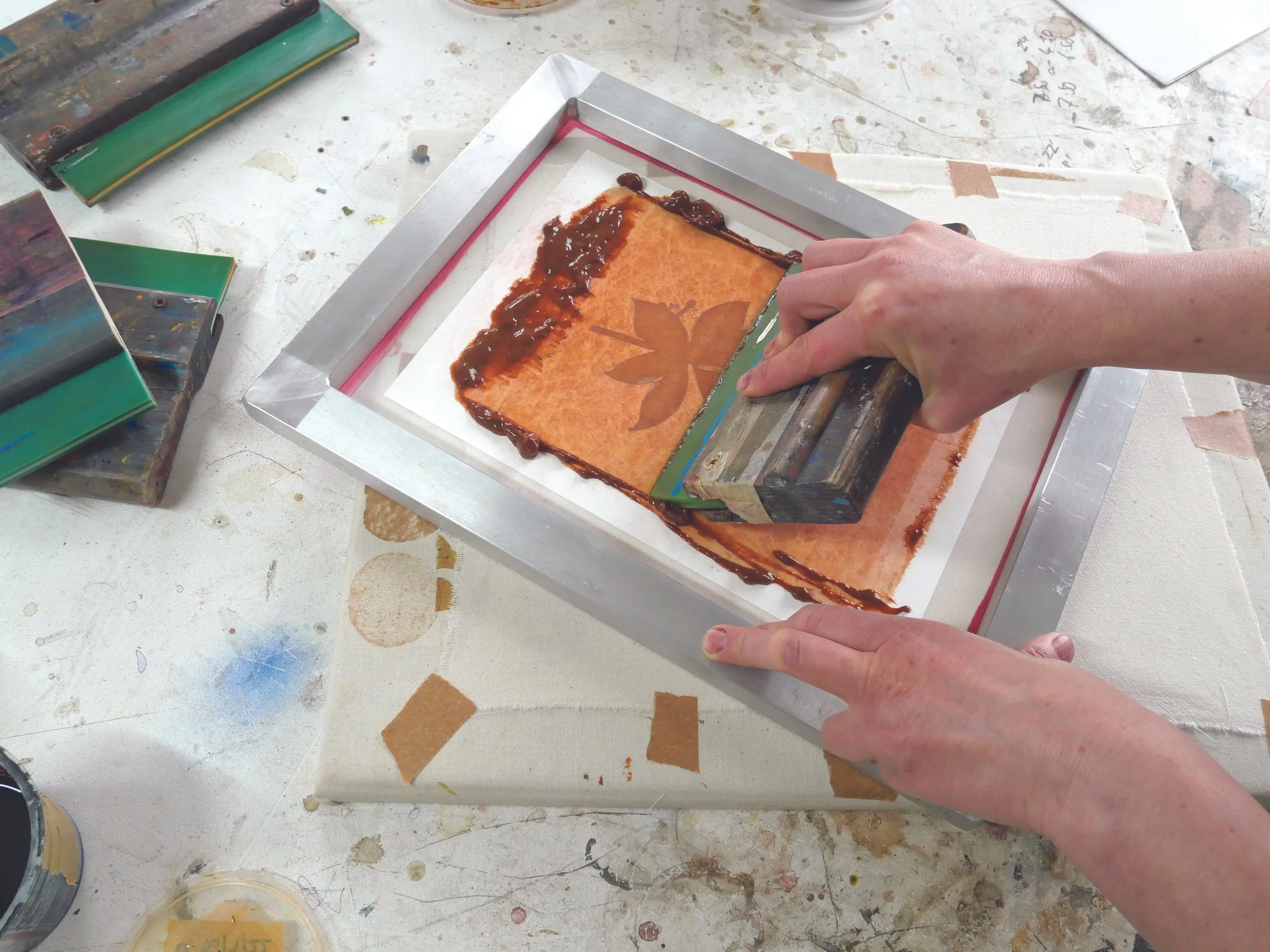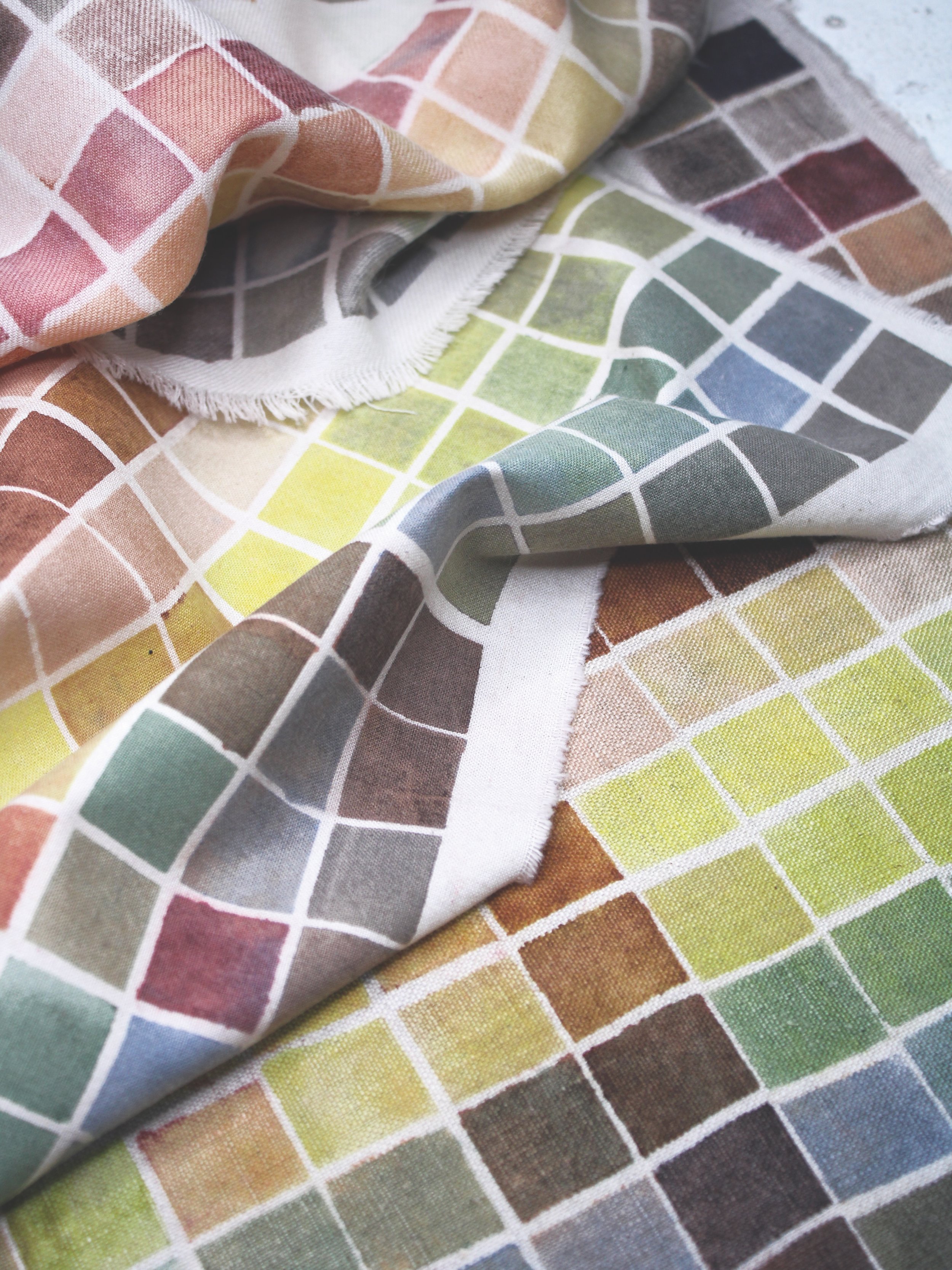


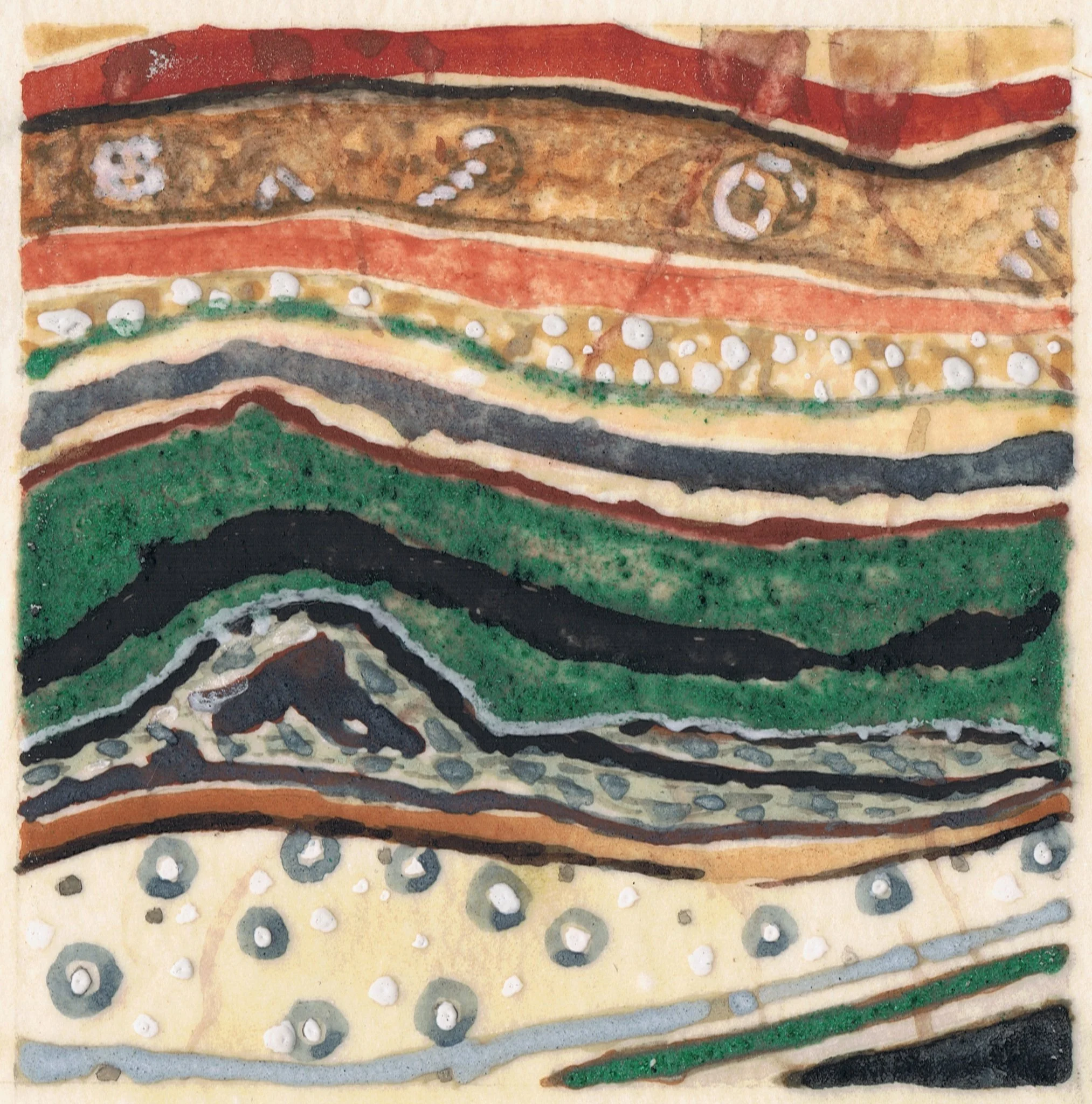
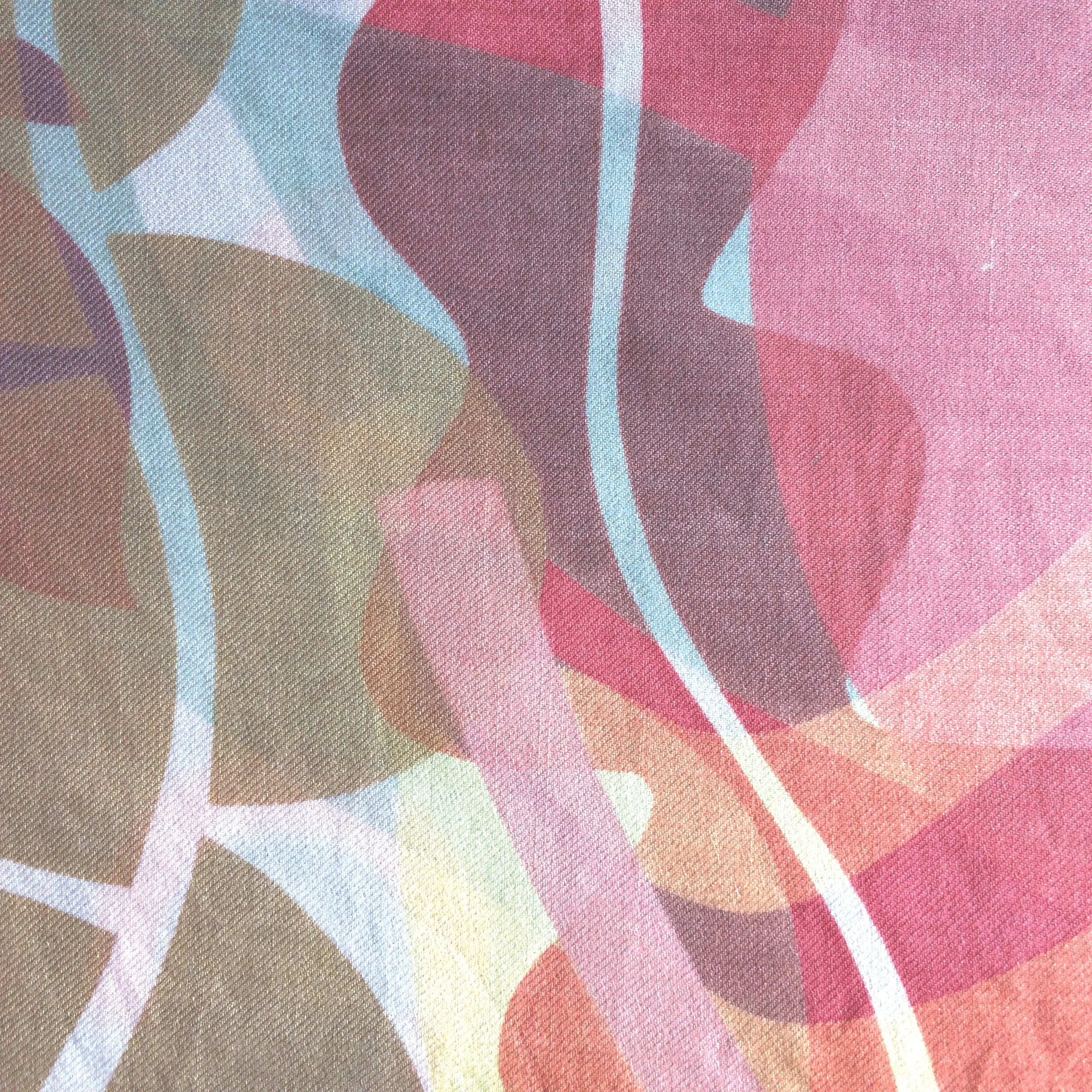

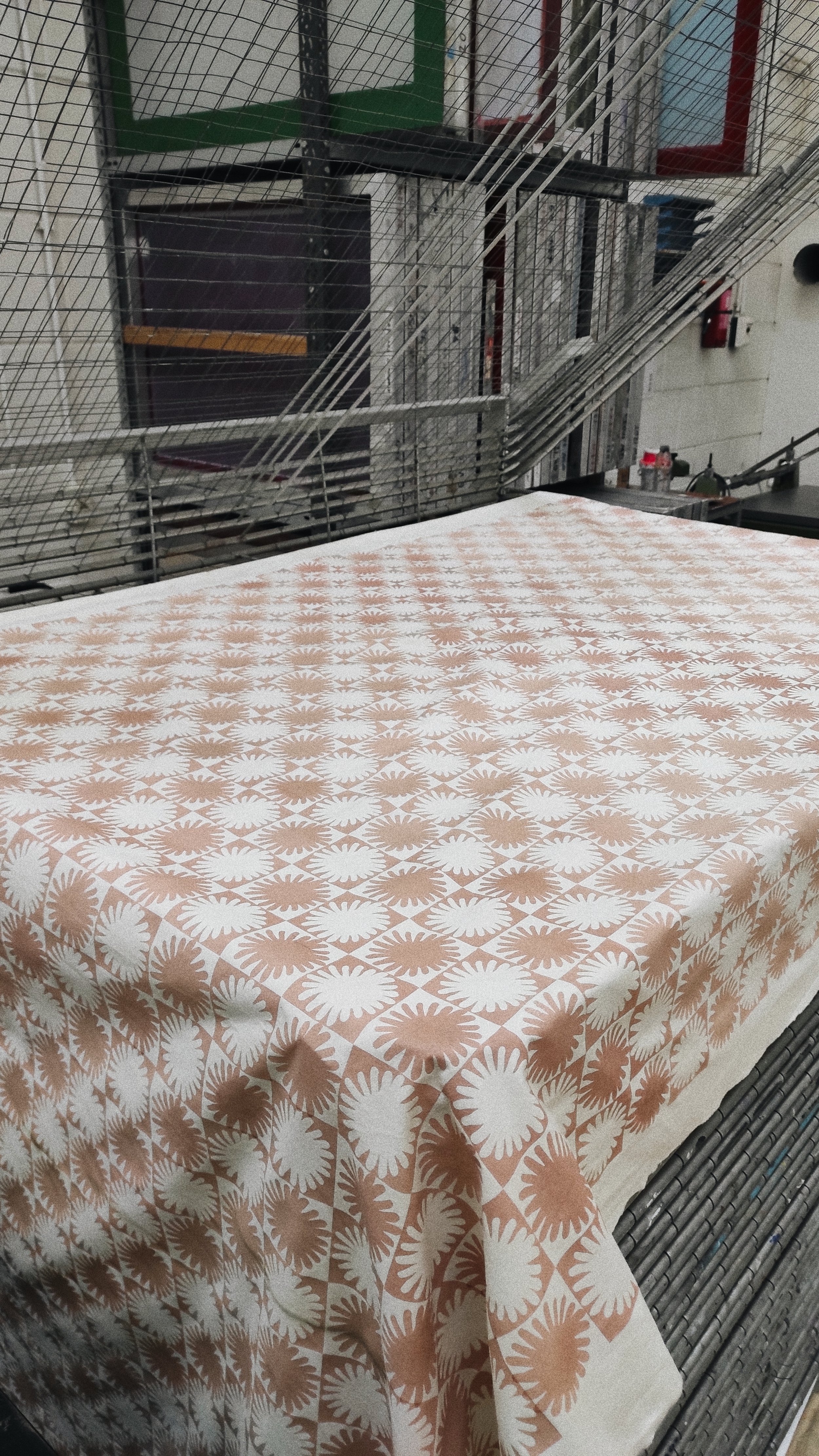


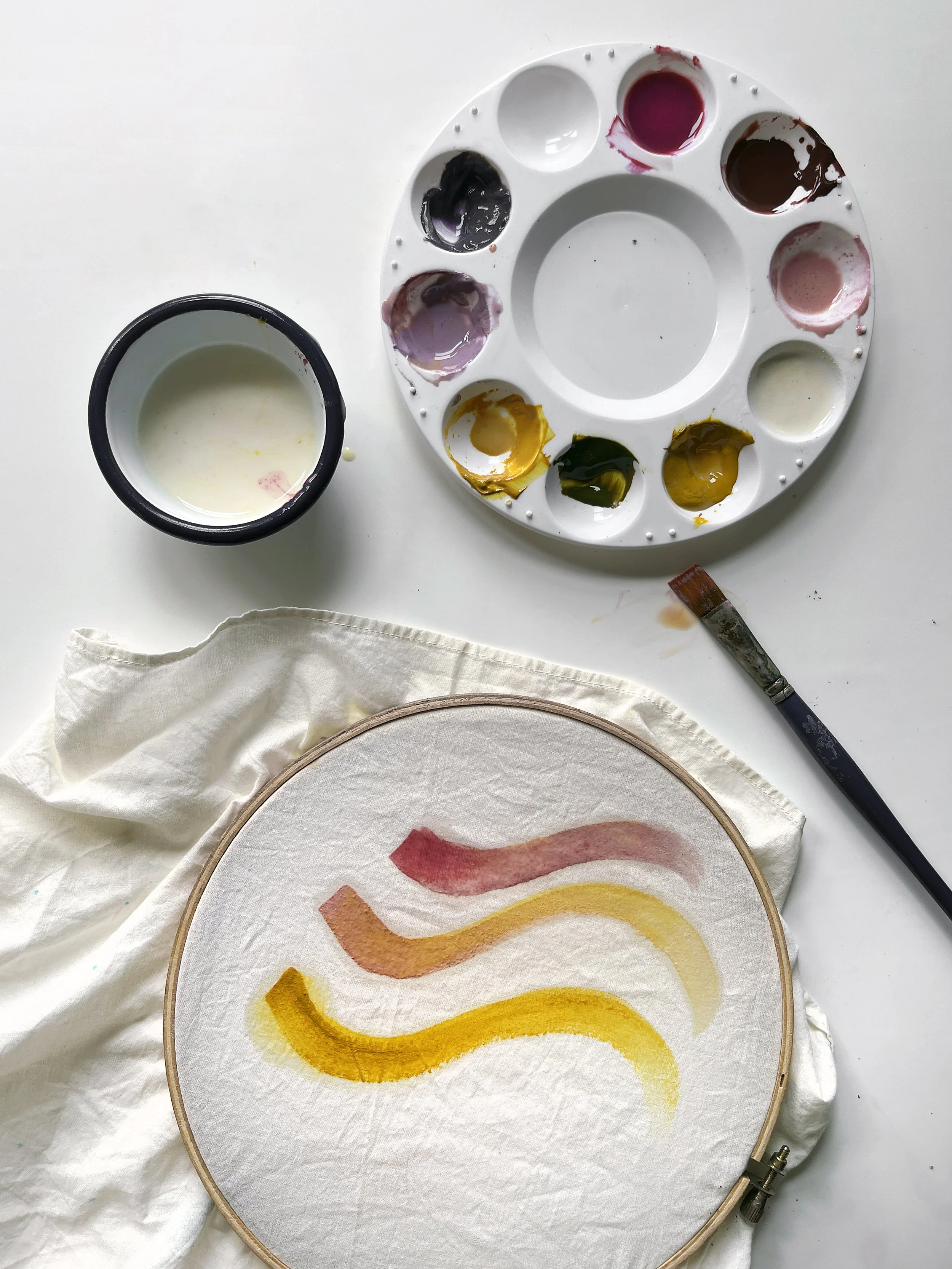
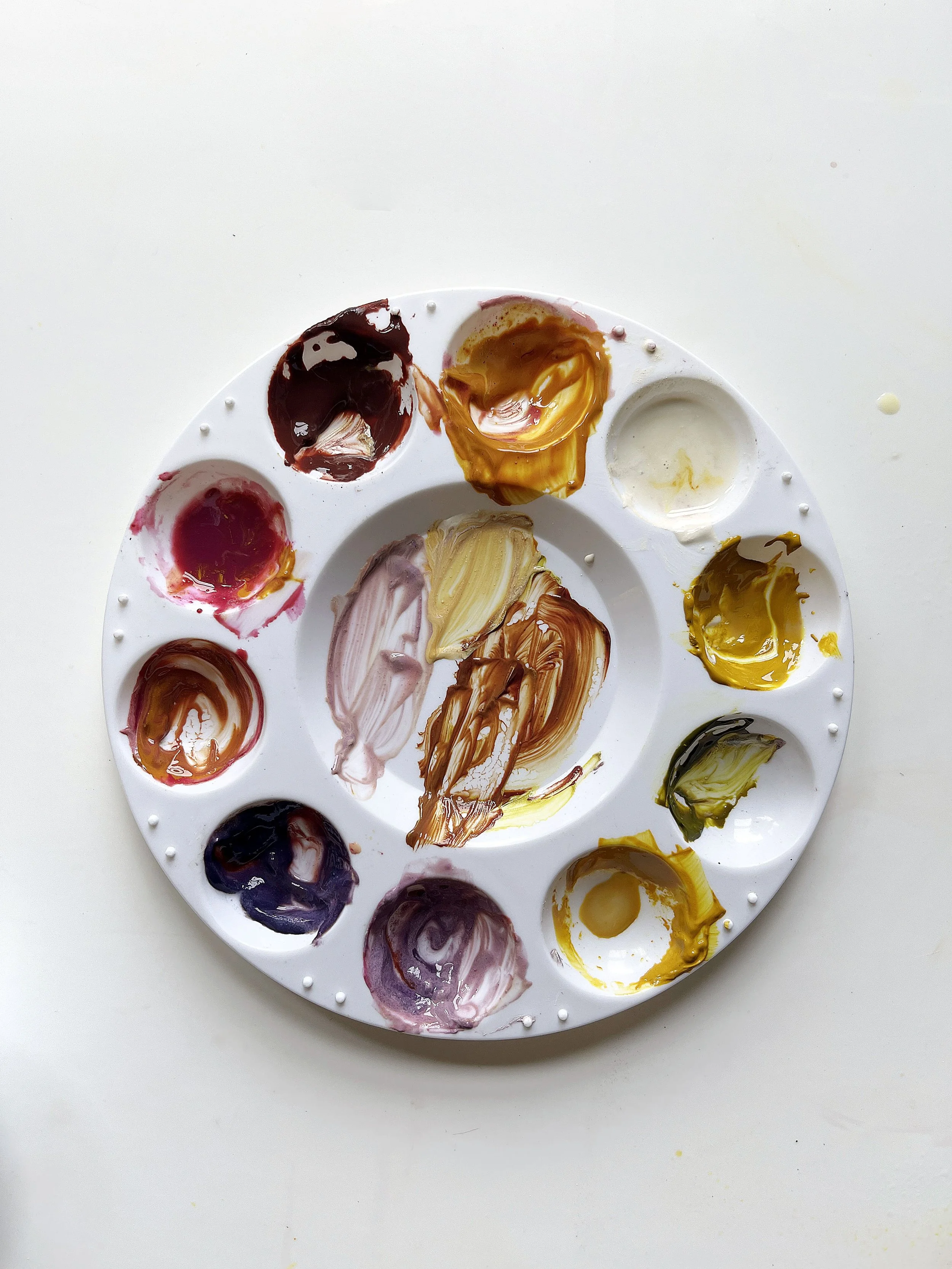

A new yearlong online course starting in January 2026
Printing & Painting on Textiles
With Natural Colour
Learn over 11 different approaches to printmaking and painting on textiles using natural colour. Taught by Natalie Stopka, Greta Facchinato, Caroline Ross, Julie Beeler, Winona Quigley, and Jacqui Symons, sharing different techniques for making patterns and prints on fabric that are light-fast and wash-fast.
THE PROGRAMME
-

In this live group session to launch the course, there will be introductions from the teachers. We will give an overview of the year ahead, what equipment and materials you will need to source, and where you can get these from.
Covering all you need to feel confident with getting started. Including studio setup and sourcing general equipment, fabric selection/sourcing, preparing fabrics for printing, and sourcing dye plants. We will also cover how to decide which technique to use.
-

Homemade soya milk is a powerful tool in the natural dye studio, serving so many functions that its potential can be clouded by misunderstanding. In this session, we’ll learn about the characteristics of this mighty legume, how to grow it at home, make soya milk, and apply it for ultra saturated color on cellulose fibers. Painterly application of soya primer functions similarly to mordant patterning, and is compatible with both mordant dyeing and our bonus topic: one-pot acid dyeing.
-

This session continues to disentangle the dual chemical and physical roles of soya protein. Today we focus on its utility as paint binder and sealant for natural pigments, indigo, and lake pigments. Soya milk greatly improves the rub-fastness, wash-fastness, and light-fastness of prints and paintings, extending the possible applications of our craft. Learn to approach soya milk with confidence and enjoy all the benefits of this natural colour ally.
-

In this session, we will explore how to create a dye-based screen printing paste using plant materials—specifically, how to extract pink hues from avocado pits and turn them into a print-ready ink. You'll learn how to thicken dye for fabric application, understand how fibre preparation (mordanting) impacts results, and explore tips for storage and application. This process is especially suited for achieving translucent, layered effects and working with tone-on-tone colour printing.
• How to prepare and modify dye from avocado pits for screen printing
• How to thicken natural dye for use as printing paste
• Tips for achieving good print quality and light-/wash-fastness
• How fibre and mordant choices influence outcomes
-

With both plant and earth-based pigments
Making screen printing pastes from pigments and extracts, comparing plant-based and earth-based sources. We will explore how the nature of the pigment—its texture, weight, and absorbency—influences the consistency of the paste and the final print outcome. You’ll learn how to adapt binders and thickeners to suit different materials, and how to work with each type to achieve durable and vibrant results. This method is ideal for achieving more opaque coverage and layering over other colours.
• How to prepare screen printing pastes using both plant- and earth-derived pigments
• The differences in texture, behaviour, and handling between pigment types• How to adapt your binder system and thickener ratio
• Techniques for layering and combining pigments for pattern work
-

This session brings together the knowledge from the previous ink-making sessions into a practical, hands-on demonstration of screen printing a pattern using natural inks. You’ll see the complete process— designing for print, preparing the screen, and managing ink flow and registration. The session will highlight key tips and tricks for clean, consistent prints, along with troubleshooting and material guidance.
• How to translate a concept into a repeatable pattern
• Techniques for screen preparation, stencil, or using photo-emulsion alternatives
• Tips for registration, alignment, and layering colours
• Strategies for printing on cotton and linen
• How to use dye- and pigment-based inks together effectively
• Post-printing care and washing tips
-

We will cover how to prepare surfaces, make and use a variety of home-made long-lasting or permanent natural inks, and ochre and mineral-based glue paints for use on all kinds of leather goods. Also covering how to make them last longer using waxes, gentle washing techniques and correct handling. This session is a perfect addition to those who love to thrift and up-cycle well-made vintage garments and bags as well as tanners looking for new ways to express themselves with their craft.
Important issues which can cause damage to leather, such as pH, salinity, UV and heat exposure will be covered and ways to avoid them will be shown. The inks used in this session will be vegan but the paints will be animal glue based.
Featured projects will include camouflage gloves, a variety of chamois, suede and buckskin bags, forest floor shoes and clothes, parchment and rawhide, vintage leather cases and more.
Including a pdf featuring simple recipes, links, books and artists. You are encouraged to bring any leather items you would like to decorate to the class so you can ask questions about appropriate materials and methods.
-

Join designer, artist, educator and creator of the Mushroom Color Atlas, Julie Beeler, in exploring the realm of working with natural pigments from mushrooms to create a variety of designs printed on fabric. She will explore different techniques for incorporating lake based mushroom pigments into different thickeners for direct printing on fabric. After heat setting the prints they will be dipped into mushroom dye baths.
Learning outcomes: After this session you will be able to make mushroom fabric paint with different thickeners and learn how to use them to print on fabric. We will explore a few printing methods from stencils, direct painting, screen printing and block printing. You will have an overview of how to heat set and dye the printed fibre.
-

Mordant printing is an alternative to directly printing plant-based colour onto textiles. Rather than printing with ‘pre-coloured’ printing pastes, different strengths of various mordants are applied to the cloth using various application techniques and with both thickened and un-thickened mixes. After processing, the cloth is dyed in a single dye bath to achieve a range of tones and shades.
In this session, Jacqui will use pre-recorded videos to show you the full process of mordant printing in detail, from mixing the pastes and applying them to the cloth through to processing and then dyeing the fabric. She will discuss fabric preparation, a variety of application techniques, how to achieve a range of tones from one dye bath and the challenges that are likely to arise when using this technique. Jacqui will recommend the best dyes and the best fibres to use, alongside showing a range of samples and mordant-printed pieces to inspire your next project. We will do some screen printing using stencils and block printing.
-

The pigment compounds found with fungi respond and react in unique ways with various mordants, creating an array of colors. Julie Beeler, creator of the Mushroom Color Atlas, will walk through using mordants such as tannins and titanium oxalate along with different thickeners for painting on fabric. After ‘dunging’ the fibres they will be dipped into mushroom dye baths.
Learning outcomes: After this session you will be able to make mordant fabric paint with different thickeners and learn how to use them to paint on fabric. We will explore a variety of painting methods with different brushes and techniques. You will have an overview of how to dung the fibre and dye the painted fibre.
-

The class will focus on a special mordanting method (for use with eco printing or natural black in solid applications), and how to blend eco printing with solids like black for more depth in colour within the print.
In this session, Winona Quigley, founder of Green Matters Natural Dye Company, will lead you through her team's process for creating a plant based black dye. Black, typically elusive with natural dyes, is a color requested by Green Matters customers for years. Our recipe for natural black was discovered while Winona was working on fine art prints with plant dyes, and found that with the right mordant technique, and layering of tannin based dyes created a deep black. Learn how to hand apply a strong mordant bath, and how to use layered tannin dyes to produce a deep black. In this session we will also cover how to use hand applied mordanting for deeper colours and clearer eco prints.
-

Various resist paste recipes and techniques are available to the natural dyer or printmaker wishing to use more sustainable techniques to create pattern and design on textiles. The techniques most often use a resist solution or a mechanical method (such as clamping or tie-dyeing) to stop colour reaching and thus dyeing the fabric.
In this session Jacqui will be introducing you to the use of a flour resist paste and how to use direct print pastes as a semi-resist. She will use pre-recorded videos to show you how to make the pastes, different approaches to printing and best techniques for achieving good results. She will briefly discuss other resists including rice paste resist, wax resist (batik) and mud resist and show you examples of these techniques.
During the session, you’ll be shown two different techniques. The first will use a flour resist to block colour when immersion or brush dyeing and the second will use repeated layering of direct print pastes to create detailed pattern and shape with multiple colours. We will do some screen printing using stencils and block printing.
-

We will have a closing session will all of the teachers to round off the course. This is an opportunity for course members to ask any remaining questions before the course wraps up, we will also reflect on the past year and set intentions for the next. We invite all members to bring their work to share during the session so we can be inspired by each-other's printing and painting explorations. This final course session will be on Wednesday 20th January 2027
We pushed the date of this session back a month, so give you some extra time before the course officially ends to catch up on all the resources. You will still have access to all the resources for another year after this session (until January 2028).
Elements:
12 monthly live online sessions.
Opening and closing sessions with all the teachers.
Eleven techniques will be shared. Eight as live online demonstrations (Watch live or recorded) and three available as pre-recorded video demonstrations. All pre recorded classes will have follow up live Q&A sessions.
Downloadable PDF handouts will be available for all eleven techniques shared. With recipes & specific equipment & materials.
A reading list
An equipment & materials overview and guide
We will have a What’s App group for the course members to communicate and share work. The teachers won’t be in the group.
Who is this course for?
This course is aimed at people who already have a basic understanding and experience of natural dyes and seek to develop their practice into surface design and printmaking with natural colour.
Access: All members will have access to the live sessions as well as the recordings in the member area on Plants & Colour Website. The resources will be available until December 2027, one year after the course is completed.
Time Commitments:
The live demonstrations will be two hours every month. You can either join live or watch the recordings in your own time.
In order to practice the techniques in your own time, this will require 6-12 hours per month of studio practice. The course is really what you make it. The more you can find the time to practice the techniques each month, you will get more from the course.
Optional Extra Resources Available for Beginner Dyers:
Introduction To Natural Dyes Online Course
With Flora Arbuthnott
This pre-recorded online course is available to access alongside this course for beginner dyers to cover the basics.
Introducing approaches to natural dyeing textiles to create a variety of colours. Specialising in effective plant based mordants (fixatives) for vibrant colours as well as mineral mordant recipes. We will look at fabric, fabric preparations, dye plants, extraction processes, and dye processes through written recipes and video tutorials.
✓ Working with plant based & mineral mordants
✓ Working with cellulose and protein fibres
✓ Wild plants, garden plants, and specialist dye plants
✓ Indigo Vat Dyeing, over-dyeing, and modifying.
✓ Video Tutorials, written recipes, and printable PDFs
Join The Course
This year long course will explore a variety of techniques for printmaking and painting on textiles using natural dyes, inks, and pigments. Twelve online sessions and demonstrations taught by artists and craftspeople, giving you a broad overview of the different approaches to making enduring patterns and prints on fabric that are light-fast and wash-fast.
Introduction To Natural Dyes: fabric preparations, dye plants, extraction processes, and dye processes through written recipes and video tutorials. Working with plant based and mineral mordants and modifiers to fix and transform colours on fabric. Creating and working with a fructose indigo dye vat for dyeing and over-dyeing. Printing & Painting On Textiles: A broad overview of the different approaches to making enduring patterns and prints on fabric that are light-fast and wash-fast.
Optional Extras:
An Online Study Group
With Jacqui Symons
12 sessions alongside the year course on the last Wednesday of each month from 6-8pm GMT
Dates: 28th January 2026, 25th February, 25th March, 29th April, 27th May, 24th June, 29th July, 26th August, 30th September, 28th October, 25th November, 6th January
This monthly online study group is for participants of the Printing & Painting on Textiles course who are looking to connect with a small, supportive creative community. It’s a relaxed, peer-led space for sharing ideas, questions, and artistic explorations.
Format: The group of up to 12 members meets monthly via Zoom for a two-hour session. The atmosphere is informal and conversational, allowing space for organic, emergent discussions. Members are encouraged to bring questions, share in-progress or completed work, and exchange creative insights.
Purpose: Connection with a global community of plant dye, ink, & paint making enthusiasts. An opportunity to share your work and insights. To get feedback around your creative explorations. To hear about what others are exploring, and be inspired by this.
Early bird payment plan: 6 Payments of £34.00 for 6 months. (Available until the end of September)
One Payment of: £180.00
How To Join: Join the Printing & Painting On Textiles Course to access the sign-up page.
✓ Just 12 Spaces Available
One-to-One Mentoring
Greta Facchinato, Caroline Ross, and Jacqui Symons are offering a limited number of mentoring spaces.
To support participants in deepening their creative practices. Rooted in community, material experimentation, and sustainable approaches, it offers one-to-one support with experienced mentors to guide, challenge, and encourage artistic development. Mentors, as practicing makers with in-depth knowledge of their own processes, can support mentees in pushing their work further. Timings are arranged directly with the mentors.
Pricing: £90/month for 3 months or one payment of £270 for 3 x One Hour Sessions To be completed within the duration of the year long course
How To Join: Join the Printing & Painting On Textiles Course to access the sign-up page.
Just 8 Spaces Available
Meet the Team



